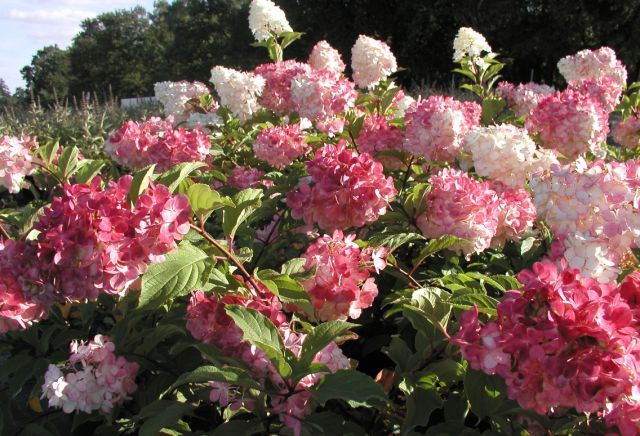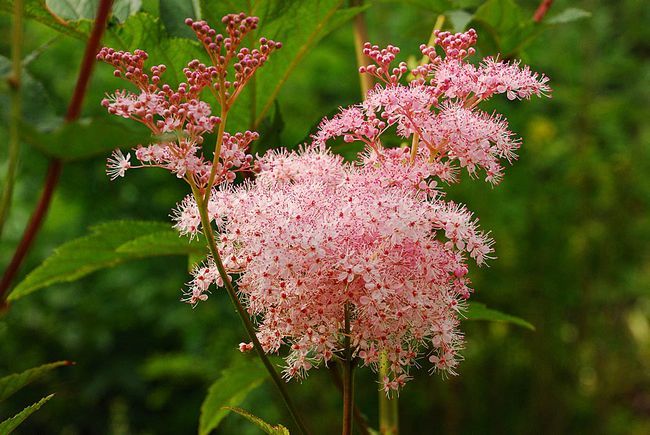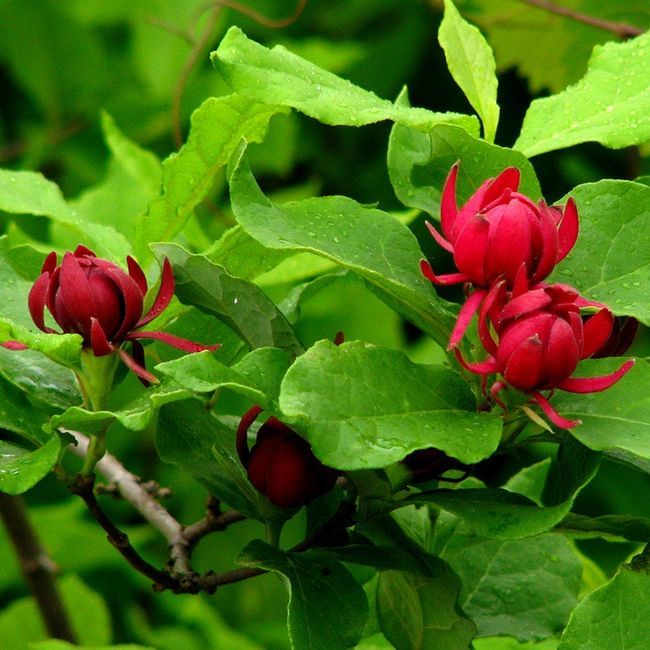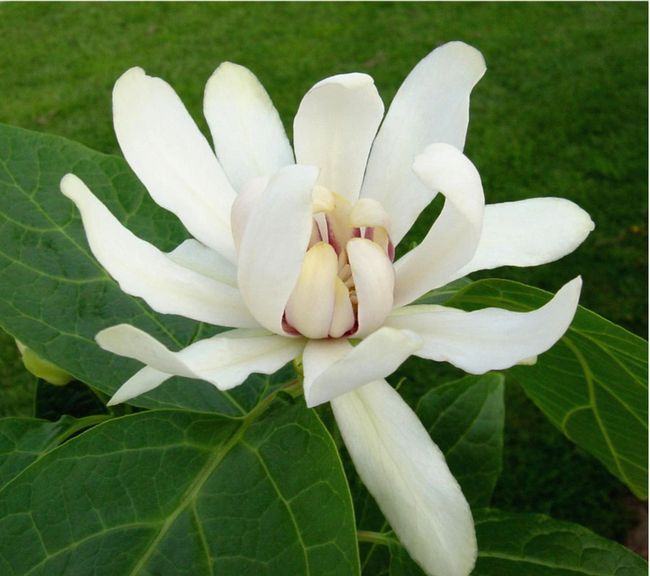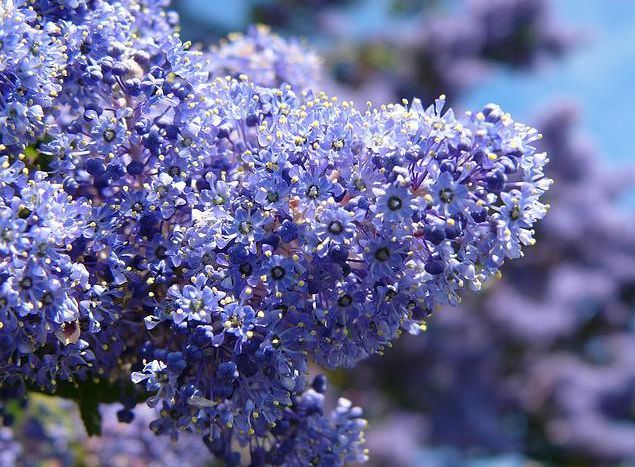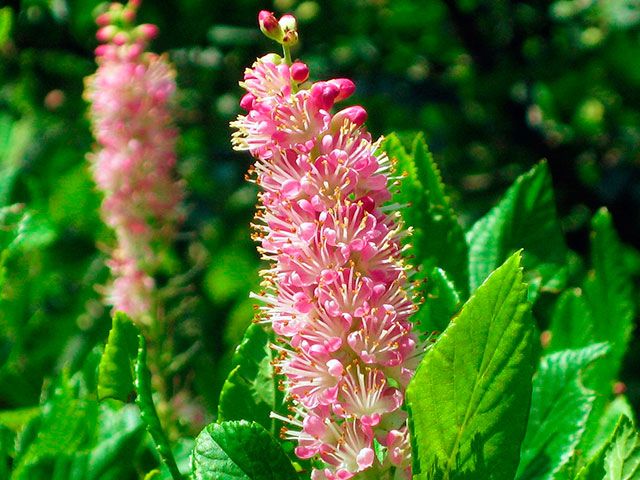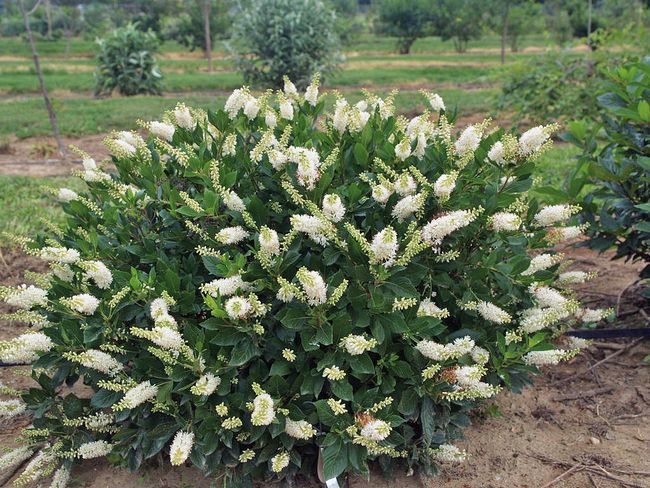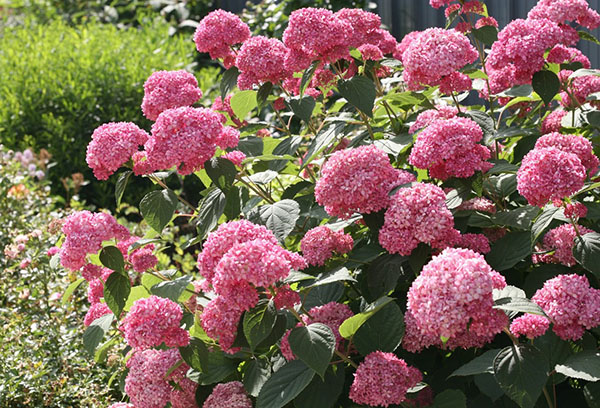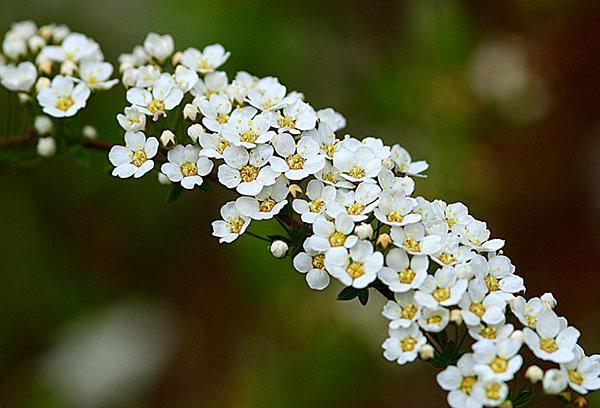With the blooming of each flower, the garden takes on a new look, and every year you want to see the flowers you like again. Therefore, gardeners love perennials. But another way to admire flowering every year throughout the season is flowering shrubs for summer cottages and garden plots. There are more than 200 species of such ornamental plants, completely different from each other and blooming their buds from the very early spring until almost autumn. We will talk about the most interesting bushes and tree-like vines that you can plant alone, make interesting compositions, decorate a house, terrace, fence.
Jasmine
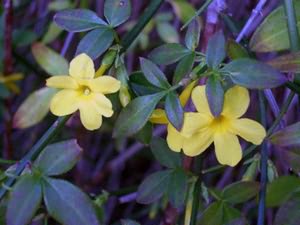 The very first, back in February, among the snow and frost, jasmine blooms. And in regions where the temperature does not drop below -10 degrees in winter, the jasmine hololithous blooms the first yellow flower stars in November - and they bloom all winter. In our gardens, you can grow about 10 types of jasmine with white, yellow, pink or red flowers. They bloom at different times. For example, jasmine officinalis opens its pink buds all summer, from June to the end of September, and its shoots grow up to 8 meters. Shrub jasmine low blooms in May-June yellow flowers. A feature of all species is an unusually pleasant aroma. Decorative jasmines do not require special conditions, except for a sunny place. Propagated by layering and cuttings in a greenhouse in July.
The very first, back in February, among the snow and frost, jasmine blooms. And in regions where the temperature does not drop below -10 degrees in winter, the jasmine hololithous blooms the first yellow flower stars in November - and they bloom all winter. In our gardens, you can grow about 10 types of jasmine with white, yellow, pink or red flowers. They bloom at different times. For example, jasmine officinalis opens its pink buds all summer, from June to the end of September, and its shoots grow up to 8 meters. Shrub jasmine low blooms in May-June yellow flowers. A feature of all species is an unusually pleasant aroma. Decorative jasmines do not require special conditions, except for a sunny place. Propagated by layering and cuttings in a greenhouse in July.
Japanese keria is completely unpretentious either to soils or to the place of growth. It blooms brightly, luxuriantly and for a long time from mid-April to June with shaggy, papery yellow flowers. There are decorative varieties in which the petals have a white or cream border. In July-August there may be a second wave of flowering, but not so abundant. This shrub requires annual formative pruning after the first bloom. Propagated by root shoots or cuttings in June.
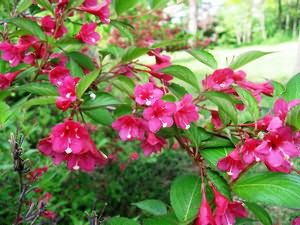 This is one of the best decorative flowering shrubs. Weigela lends itself perfectly to a haircut, but looks even more beautiful in a single planting - with long curved branches, literally plastered with bright pink or pale flowers. There is also a weigela, in which the flowers are yellow or cream - Middendorf, the Eva Rathke variety blooms in rich red. There are many varieties with colored, speckled and variegated leaves. Weigela blooms twice a season - in spring and autumn. After flowering, it requires pruning, propagated by cuttings planted in autumn directly into the ground.
This is one of the best decorative flowering shrubs. Weigela lends itself perfectly to a haircut, but looks even more beautiful in a single planting - with long curved branches, literally plastered with bright pink or pale flowers. There is also a weigela, in which the flowers are yellow or cream - Middendorf, the Eva Rathke variety blooms in rich red. There are many varieties with colored, speckled and variegated leaves. Weigela blooms twice a season - in spring and autumn. After flowering, it requires pruning, propagated by cuttings planted in autumn directly into the ground.
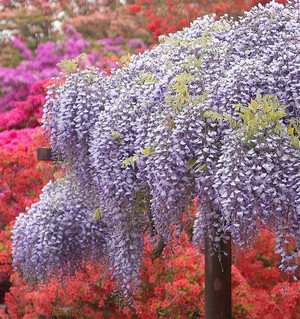 Or a more correct name - wisteria. This is a tree-like liana that blooms in April-May of incredible beauty with purple, white or pink tassels. Some hybrid varieties decorative brushes can reach up to 80 cm in length! It is a very popular plant in Japan, where entire streets are adorned with wisteria. Interestingly, its shoots curl counterclockwise and can reach up to 30 m in length. The first time blooms only 5 years after planting. In July, it is recommended to shorten its side shoots. Wisteria can be propagated by buried layers or lignified cuttings in the summer under a jar. Plant this vine near a gazebo, fence or old tree, and it will give you a flowering festival every spring for many years. Wisteria lives for more than 200 years.
Or a more correct name - wisteria. This is a tree-like liana that blooms in April-May of incredible beauty with purple, white or pink tassels. Some hybrid varieties decorative brushes can reach up to 80 cm in length! It is a very popular plant in Japan, where entire streets are adorned with wisteria. Interestingly, its shoots curl counterclockwise and can reach up to 30 m in length. The first time blooms only 5 years after planting. In July, it is recommended to shorten its side shoots. Wisteria can be propagated by buried layers or lignified cuttings in the summer under a jar. Plant this vine near a gazebo, fence or old tree, and it will give you a flowering festival every spring for many years. Wisteria lives for more than 200 years.
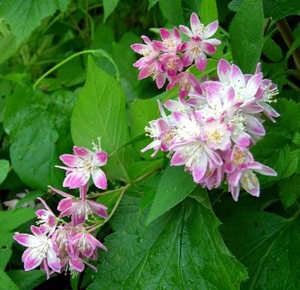 A very popular flowering perennial shrub with white to pale pink flowers. It grows no more than 1.5 meters, blooms in the summer, almost 2 months, very abundant. The action is completely undemanding to growing conditions, it is recommended to cut off the faded shoots only after flowering. To propagate this shrub, it is enough to dig cuttings 10-15 cm long in the fall, and in the spring they will already start growing. The action is very fond of aphids, so it should be planted away from garden crops.
A very popular flowering perennial shrub with white to pale pink flowers. It grows no more than 1.5 meters, blooms in the summer, almost 2 months, very abundant. The action is completely undemanding to growing conditions, it is recommended to cut off the faded shoots only after flowering. To propagate this shrub, it is enough to dig cuttings 10-15 cm long in the fall, and in the spring they will already start growing. The action is very fond of aphids, so it should be planted away from garden crops.
Cercis
A tall shrub with a spreading crown, which eventually becomes like a tree. It blooms in May-June with very bright pink-lilac flowers that cover the entire length of the stems. Pruning should be done carefully in early spring. You can propagate by seeds, or in the fall you can add layering.
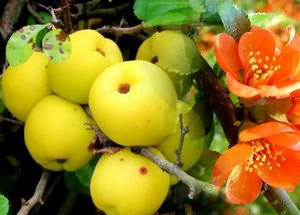 This wonderful bush not only blooms for almost the whole May with bright, large orange or red flowers, but even in autumn it will delight with fragrant fruits, resembling quince in taste and appearance, only the size of a large nut. Japanese quince grows both in the sun and in the shade, it is not necessary to cut it. If you plant chaenomeles against a wall, then it will stubbornly grow along it, decorating an ever larger surface.
This wonderful bush not only blooms for almost the whole May with bright, large orange or red flowers, but even in autumn it will delight with fragrant fruits, resembling quince in taste and appearance, only the size of a large nut. Japanese quince grows both in the sun and in the shade, it is not necessary to cut it. If you plant chaenomeles against a wall, then it will stubbornly grow along it, decorating an ever larger surface.
Spirea
This is probably the most common shrub in our parks and gardens. Some species forms more than a hundred. Spirea is a favorite bush of breeders who have bred a myriad of varieties. There is a spirea that blooms in early spring with white or pink corymbs, and there is one that blooms in autumn until frost. The most beautiful and famous representatives:
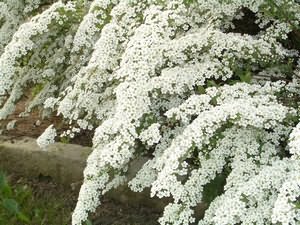
All spireas are undemanding to conditions, propagate by cuttings directly into the ground or by dividing the bush.
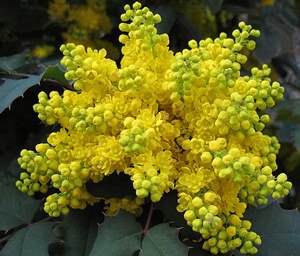 If you are looking for flowering shrubs for summer cottages that are decorative all year round, then be sure to plant holly mahonia. This evergreen shrub in spring (and there are species that bloom in autumn) blooms with very fragrant yellow flowers, blue-black berries adorn it all summer, and glossy leaves turn bronze or purple in winter. The bush can be propagated by root shoots.
If you are looking for flowering shrubs for summer cottages that are decorative all year round, then be sure to plant holly mahonia. This evergreen shrub in spring (and there are species that bloom in autumn) blooms with very fragrant yellow flowers, blue-black berries adorn it all summer, and glossy leaves turn bronze or purple in winter. The bush can be propagated by root shoots.
This picturesque shrub is rarely found in our gardens, but in vain. In the month of May, its arcuate decorative shoots are covered 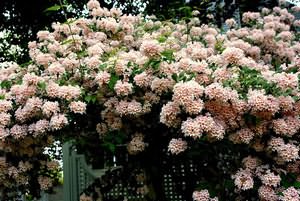 a huge number of pink drooping flowers. Kolkvitsia must be cut after flowering, otherwise it will grow up to 3 meters in height. Propagated by ordinary cuttings.
a huge number of pink drooping flowers. Kolkvitsia must be cut after flowering, otherwise it will grow up to 3 meters in height. Propagated by ordinary cuttings.
Hydrangea
The flowering shrubs also include the hydrangea, beloved by everyone, blooming all summer. And if ordinary species know everything, then pay attention to varieties such as Sargent's hydrangea, Grandiflora or climbing hydrangea.
Hibiscus Syrian and herbaceous
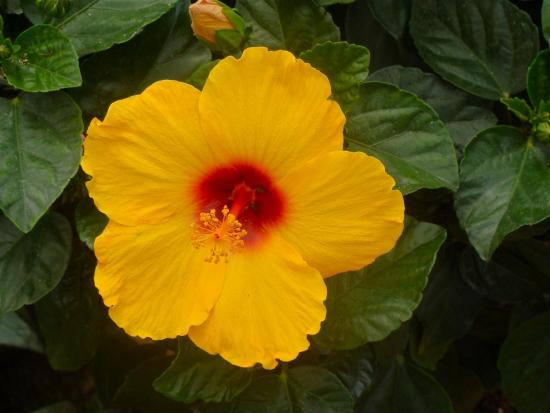 This tree-like shrub, despite its southern origin, perfectly tolerates the most severe winters and will bloom tirelessly every year from early July until the very cold. The flowers are white, pink, lilac, purple, red. Hibiscus herbaceous is a perennial bush with incredible beauty of all colors and sizes of flowers, but its shoots must be cut every year at the root. All hibiscus reproduce by seed.
This tree-like shrub, despite its southern origin, perfectly tolerates the most severe winters and will bloom tirelessly every year from early July until the very cold. The flowers are white, pink, lilac, purple, red. Hibiscus herbaceous is a perennial bush with incredible beauty of all colors and sizes of flowers, but its shoots must be cut every year at the root. All hibiscus reproduce by seed.
Hebe
A magnificent evergreen shrub that blooms brightly and profusely with tassels of rather rare blue, blue, lilac, pink and even gray color. Chebe, of which there are almost 200 varieties, is a favorite ornamental perennial shrub in Europe, and now they are confidently conquering our gardens.
Buddley
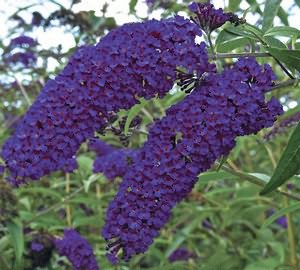 One of the most beautiful shrubs that blooms in summer, attracting hundreds of butterflies with its amazing fragrance. Two types of buddley are popular with us: David, in which candle inflorescences can reach up to 30 cm and be from pure white to black, and alternate-leaved buddley - with long hanging branches densely covered with blue flowers. Both species can be propagated by cuttings directly into the soil in the fall.
One of the most beautiful shrubs that blooms in summer, attracting hundreds of butterflies with its amazing fragrance. Two types of buddley are popular with us: David, in which candle inflorescences can reach up to 30 cm and be from pure white to black, and alternate-leaved buddley - with long hanging branches densely covered with blue flowers. Both species can be propagated by cuttings directly into the soil in the fall.
You can describe for a long, long time what wonderful shrubs you can plant in your dacha, but this cannot be contained in one article. Therefore, further we will simply list their names, and more detailed information you will find on our website. So, pay attention to such shrubs:
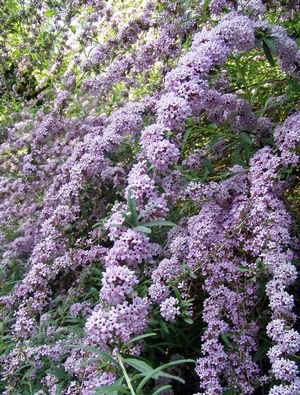
LetovSadu.ru
Overview of the most popular perennial shrubs for summer cottages with photo examples
Garden landscaping is the most important component landscape design site. The importance of plants in the design of a dacha can be felt when walking along the city streets - the dullness of concrete walls and asphalt simply requires rest in a green garden. Shrubs are one of the most popular gardening plants. In this article, we will very briefly consider the most popular types of shrubs that can be used in an original and useful way to equip a summer house and a garden.What shrubs to choose for a small garden?
Since shrubs are famous for their small stature and large width, owners of small summer cottages it is necessary to choose less voluminous shrubs so that they fit in a tiny garden. The most suitable shrubs for the garden in this case are:
Forsythia is one of the earliest flowering shrubs, which pleases with its yellow and light green colors in early spring, when all other shrubs and trees are still completely bare. Forsythia has a small size, so it is ideal for a small garden.
forsythia
Another option for a low shrub for the garden is the Japanese rhododendron, which has a wide range of colors and can blend well with the rest of the plants in the garden.
Japanese rhododendron
In order to continue the baton of flowering shrubs in a small garden, it is recommended to use lilac, which begins to bloom closer to summer.
In the summer, kolkvitia will brightly complement the composition of a blooming garden, which will give the cottage a pleasant aroma.
To small garden bloomed in autumn, it is recommended to place within it different kinds hibiscus, the color range of which ranges from bright white to purple.
Hibiscus
Well, in order for the garden plot not to do without decorative equipment with plants in winter, it is recommended to add dwarf spruce or arborvitae to the assortment of plants.
dwarf spruce
What shrubs to choose for a large garden?
In this case, you can use any shrubs you like and plant them not only alone, but also in mixborders, green hedges, etc.
So that, again, the shrubs in the garden will delight us all year round, it is necessary to select their combination, which ensures the flowering of one group of shrubs at a time when others will already finish the flowering period. Let's bring to your attention the types of shrubs that bloom in a certain season:
- Spring: all the same forsythia, Japanese quince, spirea, keria, almonds, canadian irga, wolfberry (be careful with it, because it is very toxic) and others.
- Summer: barberry, hydrangea, action, weigela, mock orange, skumpia, etc.
- Autumn: hydrangea, heather, mountain ash (which also never ceases to delight with the colors of its fruits in winter), dog rose, cotoneaster, hawthorn, etc.
The most popular perennial shrubs
There is a very wide range of perennial shrubs that can brightly complement the garden on suburban area, but the following 4 plants are considered the most popular and attractive:
samdizajner.ru
Rules for creating flower borders
Many principles for creating borders came from the famous English gardener and landscape designer Gertrude Jekyll. Her own garden at Munstead Wood was amazing with elaborate flower beds. Until now, her work is considered a model of skill and impeccable artistic taste.
Gertrude Jekyll believed that contrast was necessary to enhance harmony, but the use of neutral colors, which is considered white or silver, is also acceptable.
In order for the floral border to be functional and attractive, it is necessary to follow some rules when creating it:
- Curbs own colors should contrast with the flower garden, the frame of which they are.
- When using border low-growing perennial flowers, remember that they will definitely grow up and in breadth. Give them a little more space.
- The presence of gaps in the edging always looks untidy, so it is better to place plants of the same type in two rows.
- There are classic border parameters: width - no more than 50 cm, and height - up to 40 cm. But a flower frame doesn't have to be low. It all depends on where it is used. However, ornamental shrubs and even such annuals as kochia lend themselves perfectly to a haircut and look very attractive.
- It is important that the frame does not fall apart on different sides, has a well-groomed and neat appearance. To do this, choose compact plants that grow slowly.
- The decorativeness of plants cannot depend on weather conditions. And in the rain, and in the scorching sun, the flowers should look good. Therefore, for borders, the most unpretentious plants are chosen, which are distinguished by their endurance even in conditions of a limited place for growth.
Based on the foregoing, it becomes clear that the choice of plants for planting in borders - key moment creating a quality border.
Fencing flowers are always dangerously close to feet and lawn mowers, so the fast regeneration of plants is another principle by which they should be selected.
Annual plants as part of a flower border
Annual plants live for a short time, but bright life. In early spring, their seeds are sown in order to get seedlings. In summer they turn into blooming bouquets, and wither in autumn. Every year, the edging of the border flowers of annuals will have to be renewed. But this drawback is the only one, and it is completely redeemed by the advantages of a border of annual flowers.
Such plants, even bought already in the form of seedlings, are inexpensive, and they bloom very beautifully. Even in the very fact of their annual renewal, there is a positive: you can create new beautiful combinations of plants. Below we give you a small list of the best varieties.
Marigold. Among the many varieties of these plants, preference should be given to undersized border flowers. Marigolds bloom from June until the coldest. There are varieties of marigolds with double and simple flowers. A slight shade does not interfere with their growth and flowering. Marigold seedlings are planted in mid-May.
Marigolds never look too simple: the plants are diverse, attractive and not boring: there are both simple and terry varieties
Nasturtium. This plant loves heat and light. Landed ahead of time nasturtiums can freeze. Nasturtium does not tolerate transplanting, so it needs to be grown in peat pots. If the plant has little light, it may stop flowering and grow. Moderately fertile and moist soil is ideal for nasturtium.
Nasturtiums will decorate the site both as border colors, and in hanging baskets, and even just in decorative pots placed along the path
Verbena. It is important not to make a mistake and choose a stunted plant. Verbena seeds in April can already be planted in the ground if covered with a film on top. This drought-resistant and photophilous plant does not tolerate excessive watering.
With marigolds and marigolds, verbena can be in alliance, and for rudebeck and gelenium they create a sharp contrast.
Ageratum. Among annuals, flowers with such an amazing blue color are a rarity. In order for the seedlings of this plant to be healthy, it should be planted closer to the end of March or early April. Ageratum blooms in June, and fades only by September.
It is important not to plant the plant in the shade and not overfertilize the soil, otherwise there will not be enough flowering, overgrown ageratum can be cut
Iberis. In March-April, the seeds of this plant can be sown in the ground. You just need to place them immediately at some distance from each other, because the plant often suffers when transplanted.
Iberis is planted in borders, as a rule, together with tall annual flowers: it creates a wonderful snow-white background that makes the garden elegant
Lobelia. This plant loves the sun. Its pink or blue flowers open in June and bloom profusely until frost. Seedlings of these plants should be placed under glass.
Look at these flowers and think about whether you would like to have on your garden plot this amazing royal blue was present
Cineraria. Undemanding and unpretentious cineraria look gorgeous, but are very sensitive to waterlogging of the soil. In the shade, the wonderful silver shade of the plant can turn into an ash gray. The plant propagates by seeds.
This magnificent plant bears a slight resemblance to corals and, like corals at the bottom of the sea, has a strong attraction power.
Alyssum. Alyssum sown in early spring directly into the ground under the film will bloom 1.5 months after germination. Likes cool weather, exudes a delicate aroma that attracts butterflies and bees.
The delicate aroma of this plant is able to lure bees and butterflies to it, and the fragile insecurity of flowers attracts the attention of people.
There is simply not enough space to present numerous annuals that are perfect for borders.
Perennials - a worthy frame for any flower bed
Border perennial flowers are called plants that allow their upper grassy part to die with the onset of cold weather, while their rhizomes simply fall asleep for the time being. In spring, it is time to wake up and new shoots grow from the roots so that flowering does not stop for many years.
chives. Otherwise, this plant is called skoroda. This is a bulbous plant that reproduces very quickly. You can plant just one onion in the spring, and by the autumn a valuable bunch of onions will grow out of it.
Sun, lime-rich soils and moderate watering are the main priorities of this plant, chives can be used as food
Arabis. This honey plant can produce white, pink, red, lilac or pink flowers. It all depends on its variety. Small flowers can even be double.
Collected in a brush, arabis flowers appear in April and remain in excellent condition for up to 8 weeks, arabis can grow significantly
Avens. The plant reproduces well both by seeds and vegetatively. Large flowers are rich in nectar, very decorative and attractive. Gravilat seeds planted in the soil can hatch by autumn, but usually mass germination occurs only in the next spring. Gravilat is also valued as a medicinal plant, but it is also beautiful simply as a border flower. Gravilat forms rosettes for the new year of flowering right under the cover of snow.
Gravilat is also valued as a medicinal plant, but it is also beautiful simply as a border flower, it forms rosettes for the new year of flowering right under the cover of snow
stonecrops. These light-loving plants can tolerate only slight shading. Bright and juicy stonecrops in the shade become completely unlike themselves. They can even lose their shape. But the sun can give this plant a real tan or a special blush. However, the shoot-bearing sedum, for example, does not tolerate direct sun and puts up with shade. Stonecrops can grow in one place for about five years.
tenacious. This variety of evergreen border undersized perennial flowers covers the ground with a continuous carpet. Differs in endurance and unpretentiousness. The leaves of the tenacious are dark green and even purple. Shade may vary depending on weather conditions and time of year.
The tenacious blooms with blue flowers at the same time as iris and Japanese spirea, this plant is often used not only for borders, but also for rocky hills
Feverfew. This plant is notable for its numerous flowers, which are very similar to daisies. propagate feverfew better seeds. They are sown in a greenhouse in March.
The plant is necessarily subjected to picking, and in June the seedlings are already planted in open ground. The golden color of pyrethrum leaves will remain only in conditions of planting on the sunny side.
If someone thought that this list represented at least a third of all the plants that are used for borders, he was mistaken. Border plants are remarkable precisely because their list is inexhaustible. From them you can create amazing ribbons, as Gertrude Jekyll once did, forming play of colors and play of shades under the influence of impressionist artists.
diz-cafe.com
Ornamental shrubs for a dacha garden, garden shrubs - photos and descriptions, expert recommendations, flowering ornamental shrubs for small and large gardens.
The ideal plant is shrubs for the garden- they are suitable for the territory with almost any area, unpretentious and easy to care for, and have an excellent appearance. They delight the eye of the gardener and summer resident from early spring to late autumn and successfully perform the function of a hedge, giving the site a well-groomed appearance. By choosing shrubs that give abundant flowering, the gardener will get a lot of pleasure during the summer holidays and will be able, having renounced the bustle of the city, to spend time truly in a paradise.
Shrubs are tall and medium height, as well as low, coniferous or deciduous, fast-growing and moderate growth shrubs. The life expectancy of a shrub depends, as a rule, on the conditions of its growth. The shape of the crown of a shrub is the most important decorative quality of this plant for the architectural composition. The shrub can be a clear geometric or sprawling shape. The crown is natural and obtained by molding, as a result of the work of specialists on a shrub.
In the Mospitomnik Company nursery, specialists work on each specific tree and shrub offered for sale, giving it a beautiful shape or preserving its original appearance, growing all plants in the most favorable conditions. Therefore, our shrubs are the best choice for the garden, we suggest ordering ornamental plants from us inexpensively.
Ornamental shrubs for the garden - a great solution for those who love their garden
For any person, his garden is an unusual place. Here we can take a break from the hustle and bustle of city life, enjoy the unity with nature, recharge the necessary energy for everyone. modern people life energy. That is why everyone strives to ensure that this place is comfortable and beautiful. And, of course, no well-groomed garden can do without shrubs. Shrubs for the garden- one of the most important parts in terms of landscaping. According to landscape designers, ornamental shrubs are designed to smooth the transition from small herbaceous plants to slender tall trees. Everyone likes them, they create a unique impression of the beauty and harmony of space, and their huge variety allows you to create according to your taste, embodying any landscape ideas, and create a little world with your own hands, in which all family members will be free and pleasant to relax.
To the delight of people, nature has created a huge number of a wide variety of plants, and shrubs are no exception. Whatever they are, differing from each other in shape and color, some bloom, others do not, some bear fruit - others do not, etc. But each of them is unique and beautiful in its own way. We offer you a huge selection of ornamental shrubs for every taste. We will help you make right choice, choose shrubs that are ideal for your garden and purchase plants that will become your favorites.
Ornamental shrubs for a small garden
If you have a small garden, then the first thing you should pay attention to is the flowering time of ornamental shrubs. In addition, it is important to take into account their size, choosing not particularly large specimens. The most rational in this case will be the choice of shrubs, the flowering of which will gradually replace each other. To do this, you need to choose from ornamental shrubs that bloom in different times of the year. Thus, by skillfully selecting plants, you will ensure that your garden will bloom all year round, pleasing to the eye.
Ornamental shrubs for a large garden
Happy owners of large gardens have much more opportunities for creativity. If you are one of them, then you are in luck, because you are free to choose your favorite ornamental shrubs of any size and shape, based on your tastes, preferences and aesthetic considerations. The only thing that can be recommended, as in the case of a small garden, is to think over the moment of seasonality of this or that shrub in order to be able to enjoy their beauties all year round.
Perennial ornamental shrubs
Another important factor that you should pay attention to when choosing an ornamental shrub for your garden is whether it is annual or perennial. Perennial are those ornamental shrubs that grow in one place for more than two years, while maintaining their decorative qualities. It is quite understandable that perennial shrubs are the most ideal option for you, since they do not need to be replanted annually. In addition, such perennials less whimsical in comparison with annuals. The most common flowering perennial shrubs include: Japanese quince, weigela, jasmine, hydrangea, garden hibiscus.
| Japonica |
Japonica. For example, Japanese quince is considered one of the most beautiful and brightly flowering shrubs that bloom in spring. She has bright red or bright pink flowers that just burn among the green leaves. In addition, it is quite frost-resistant.
Weigela. One of the first shrubs to delight you with its many pale yellows, reds and purple flowers in summer, this is weigela. This is a strong and unpretentious plant, the height and width of which reaches 3m. If you ask her well, then she can please you with repeated flowering at the end of summer.
But shrubs, equal in strength to the exhaled aroma, jasmine simply no. That is why many people like to keep it in their garden so much. In favor of jasmine, its unpretentiousness also speaks. He is not afraid of frost, wind or drought. But he still loves to live in the sun. At the end of summer, bright blooming hydrangea balls against the backdrop of juicy green leaves look simply gorgeous.
Hydrangea it is also an excellent option when choosing a flowering perennial shrub, as it is extremely hardy and frost-resistant, it can be planted both in the sun and in the shade. Interestingly, the shade of hydrangea inflorescences is strongly influenced by the acidity of the soil - the higher it is, the brighter the colors. Hydrangea is extremely negative about lime soil, but in a humid environment it will feel perfect.
Let's look at what flowering shrubs are best to choose, focusing on the time of year, in order to get the best result, in which the flowering of some plants will smoothly change the flowering period of others.
Ornamental shrubs blooming in spring
Spring is the time of the rebirth of nature, therefore, to observe flowering at this time is more natural and desirable than ever. Shrubs that bloom in spring include the most popular plants such as lilac, spirea, Japanese quince, Canadian shadberry, keria, forsythia, wolfberry, and almonds.
Lilac- one of the most beautiful and diverse flowering shrubs that bloom in spring. In addition, it is not whimsical at all, does not require special care, including constant watering. Lilac bushes can be used for any purpose, for example, when you need to highlight something or vice versa - hide it.
Spirea, or as it is also called meadowsweet, one of the best choices for your garden, it is also unpretentious, frost and drought resistant, grows very quickly, pleasing the eye for decades. It will suit any of the possible soils, does not require regular watering, and is simply irreplaceable in terms of decoration and garden design.
Japonica. Everyone has heard about such a shrub as quince, just like many people know the tart taste of its fruits, from which amazing jam is obtained. The most common is the Japanese quince. This shrub is also quite frost-resistant, but if the conditions are really harsh, then for the winter period, until about the end of April - the beginning of May, it will have to be bent to the ground, covered with burlap. Quince looks great both in a single copy and in group plantings, it will look especially impressive among the stones of an alpine hill or at the entrance to a garden house.
Irga canadian- an unusually beautiful shrub, ideal for creating hedges. It is also successfully used in solitary and border plantings, and by selecting different types of shadberry, you can easily make very interesting decorative compositions.
Kerria- a very elegant ornamental flowering shrub with drooping branches and leaves, as well as bright yellow fragrant flowers. Differs in high winter hardiness. She is especially loved for her lush sunny-bright flowering, which, starting in spring, does not weaken until the summer itself, and then continues until the very frosts, although already less plentiful.
forsythia one of the first to bloom in spring, when other plants are still naked. Flowers on it appear long before the leaves, while many small golden yellow flowers bloom on the bushes.
Almond- one of the most beautiful flowering shrubs, especially during its spring flowering. It also blooms very early when the plants around look rather dull after winter. Many also know that almonds bear fruit, and its fruits are very tasty and healthy. It is worth noting that, despite the high frost resistance of almonds, it is difficult to tolerate frost in the spring, during its flowering period.
Ornamental shrubs blooming in summer
Summer is simply created in order to enjoy the beauty of flowering plants. It is especially worth highlighting such shrubs blooming in summer as mock orange, weigela hybrid, barberry, rose, wild rose, hydrangea, as well as tannery.
Chubushnik also called garden jasmine, because their blooms are very similar. This magnificent plant with wonderful fragrant flowers is becoming more and more popular in our gardens. It is unpretentious, easy to propagate, completely undemanding in care, and also very aesthetic.
Weigela hybrid not inferior in aesthetic sense to other shrubs, it has small beautiful flowers of various colors in the form of bells, as well as unusual leaves - green, with white bordering or purple, due to which the weigela bush looks truly chic both alone and in a group.
Barberry is a lush bush, the berries of which are very rich in vitamin C. A variety of sweets are prepared from them, they are used as a seasoning for meat dishes, pilafs. This is one of the most beautiful shrubs. But be careful - it has a lot of protective spikes.
Rose. There are probably simply no people who would not know or would not love roses. This is one of the most important, common and beloved by many flowering shrubs. The huge variability and aesthetic qualities of roses make it possible to create anything, enjoying their unique beauty and aroma.
Rose hip. No less than roses, wild rose is also known. This is not only a beautiful flowering, but also a very useful medicinal plant, from which tasty and healthy jam is made. Growing it is a pleasure, because it is frost-resistant and completely unpretentious.
Hydrangea or hydrangea - also a very beautiful plant, characterized by a very high moisture content. So think about it before planting it in your garden. As for its aesthetic qualities, we note that even one small hydrangea bush can completely transform your garden.
Skumpia tannery- a truly extraordinary plant, the benefits of which can be listed for a very long time. Its main advantages include: winter hardiness, beauty from spring to autumn, its large leaves and original fluffy inflorescences are especially good, many decorative and varieties with purple, resistance to urban pollution, drought resistance, durability. Surprisingly, skumpiya lives up to 70 years, and when good conditions- up to a hundred.
Ornamental shrubs blooming in autumn
The most successful flowering shrubs in autumn are rightfully referred to as panicled hydrangea, cotoneaster splayed, mahonia, European spindle tree, mountain ash, wild apple tree, viburnum, cold-resistant abelia, hawthorn and wild rose.
Paniculata Hydrangea Phantom- one of the many varieties of hydrangeas, like all plants of this species, it is extremely moisture-loving. Otherwise, she is completely unpretentious. And it is called paniculate for the shape of the inflorescences, similar to a panicle. The color variety of this shrub is simply amazing in its diversity.
Cotoneaster brilliant- one of the representatives of the cotoneaster, - unpretentious and resilient, tolerates a haircut, which makes it very attractive to gardeners. It is often called the king of parks and squares, which is no coincidence, since its dense crown noticeably distinguishes it from all other shrubs.
Deserved love for itself due to the undemanding composition and acidity of the soil, it can easily grow on any, even heavy clay soil. As for the shortcomings, the plant is afraid of direct sun and constant wind. She does best in the shade.
Euonymus winged or "spindle tree", has large leaves, somewhat reminiscent of laurel leaves, which become bright and multi-colored in autumn. European euonymus has a dense root system, can grow on both wet and fairly dry slopes, loves alkaline soil. In addition, it is winter-hardy, grows quickly and tolerates a haircut well.
Rowan- one of the most popular plants in our country. Looking at her bright red clusters, especially when the frost has already hit, is a special pleasure. They seem to burn on the branches of a plant. Interestingly, mountain ash is beautiful at any time of the year, and caring for it is not difficult.
Decorative apple tree Royal Beauty- it is rather a small tree with a rounded, spreading or spherical crown. When it blooms, it is an extraordinary sight. The fruits of the wild apple tree can be very diverse in shape and color. This is a long-lived plant, completely unpretentious and easy to care for. Snow-white caps of flowers in spring, bright ripe berries, after which bitterness remains on the lips, and scarlet heart-bones inside - such a tree simply could not help but become a poetic symbol for our people.
Viburnum vulgaris Buldanez- no less popular in our open spaces than mountain ash, and its fruits are widely used in traditional medicine. The decorative properties of viburnum are also quite high, and unpretentious care makes it one of the favorite evergreens.
Abelia cold-resistant - a very delicate flowering shrub with fragrant flowers that look like a bell or funnel. With good care, it can grow up to 4 meters. It is very easy to maintain, it is easy to propagate, it blooms very beautifully, exuding an incredibly pleasant aroma.
Hawthorn is very fond of many gardeners for its decorative effect, these bushes can be used as a hedge. Hawthorn fruits are a remedy recognized by folk medicine against cardiovascular diseases. This ornamental shrub has leaves that are almost invisible in summer, but in autumn they just burn, but when it blooms, it is covered with white, pink or red flowers.
Ornamental shrubs blooming in winter
Having shrubs in your garden that bloom in winter is very tempting for all gardeners without exception. You can recommend choosing a yew berry, derain, wild rose, as well as juniper.
Yew berry - it's forever green color A perennial ornamental shrub that can grow up to 30 meters. He loves shade, partial shade, as well as diffused sunlight. Prefers moist soil, so needs careful watering. Feels great in almost any type of soil. It tolerates shearing and shaping pruning.
Derain is a decorative flowering deciduous shrub of the dogwood family, a perennial, reaching a height of 4 meters. Likes direct sunlight, partial shade, as well as moist soil of any type. Light-loving, shade-tolerant and undemanding to the soil plant.
And the last one we'll talk about, juniper is a perennial evergreen shrub of the cypress family. coniferous plant hence many of its healing qualities. Height can reach 30 meters. Likes direct sunlight, moist to moderately moist soil. Decorate and ennoble any garden, fill it with a unique healing aroma.
MosPitomnik.ru
- Reviews, comments, additions
If there is such a desire, summer residents are limited to planting flower beds, believing that caring for flowers is easier than growing an ornamental bush. This is far from the case, since many varieties of bushes do not require special care and are able to grow on their own - without daily watering and other treatments. In order to accurately determine the choice, you should understand a little about the varieties of these beautiful plants.
Shrubs to give: types, names, photos
Shrubs for growing in a country house within Russia more than one and a half thousand varieties can be counted. Each of the species requires certain care, concluded in watering, processing, or simply carrying out the correct planting - in a more suitable area for the plant.
The criteria include both the presence of shading in the garden plot and the predominance of winds, as well as the suitable climate of the region.
Winter-hardy shrubs that bloom all summer
Winter-hardy shrubs, which bloom all summer in the summer - here main feature when choosing the type of plant for subsequent planting. Indeed, in most regions of Russia, a harsh or temperate climate prevails, and beginner gardeners do not want to carry out additional actions to warm the shrub for the winter.
Flowering hardy ornamental shrubs are especially popular. Among them are the most popular:
Lilac is a beloved shrub that can reach a height of 3 meters. Of course, such heights are not needed within the garden plot, since the branches will shade the crop in the beds. Therefore, the lilac shrub should be cut in accordance with the established rules - in compliance with the frequency and principle of pruning. Many gardeners doubt the planting of this shrub, believing that the lilac will not withstand the harsh winter. In this regard, you can play it safe and choose those varieties that are intended for growing in a harsh climate. These varieties include terry lilac "Alice Harding" and "Paul Tyrion". If there are doubts about durability, you can cover the shrub with any covering material in the late autumn.
Spirea is a shrub that, during flowering, takes on a cascading shape due to the severity of numerous small flowers. white color. This variety is divided into sub-varieties, where specimens are isolated that bloom in spring or summer. Thanks to this feature, you can enjoy the beauty of shrubs from May to October ( plant two bushes side by side different periods flowering). Sub-cultivars can reach a height of 2.5 meters. To prevent this from happening, immediately after flowering, the shoots must be cut off. Japanese varieties "Golden Princess" and "Shirobana" are more popular among gardeners. These shrubs are quite miniature and, with the right approach to cultivation, reach a height of only 70 cm.
Buddleya - intended for cultivation in regions with a temperate climate. A rather heat-loving plant, but it will withstand even a cold winter, if it is first spudded and covered with spruce branches. Its popularity is inferior to the two representatives listed above, although this is not deserved. Buddleya differs in flowering time. Gardeners can enjoy the beauty of large lilac clusters from July to October. If the region has warm weather in early autumn, the flowering time is slightly shifted in the corresponding direction. This shrub, if desired, can be given a beautiful and unusual shape. Every time after flowering, the shrub is pruned.- remove reddish shoots and branches. The free growth of the shrub contributes to reaching a height of 3 meters. Hydrangea is a tree-like plant that pleases the eye with large inflorescences. Easily tolerates the most severe winters. Requires pruning of shoots and branches twice a year. The first procedure is carried out after flowering in autumn, where it is necessary to remove all shoots that have not yet acquired a tree form. The second pruning of the shrub is carried out in the spring - the tops of the branches are cut off to the very top unblown bud. Of the needs, regular feeding can also be distinguished. Compositions for the implementation of the presented procedure should be chosen with a high content of iron and magnesium.
This is just the most common types of shrubs for the garden able to easily endure severe frosts. Before planting any plant variety, it is recommended to study all the information necessary to create conditions for a comfortable stay of the selected shrub.
Ornamental shrubs that bloom all summer, video:
Perennial shade-loving shrubs for the garden
shade tolerant shrubs- Another type of popular plant for growing in the garden. They are often planted by novice gardeners who have just acquired a summer cottage and are trying to decorate it.
Usually, shade-loving shrubs landed along country house and other outbuildings. They can cover the unpresentable appearance of buildings and at the same time not harm the very growth of the plant.
For planting in the shade, shrubs such as:
Wisteria - can reach a height of 18 meters. These flowering shrubs are often used to decorate any erected arch or ugly building. It is enough just to pull the threads, having previously wrapped them around a bush or branch, in the shape you need. Small flowers with a bright aroma bloom from late spring to early autumn. Weigela - low shrubs, reaching a height of only 70-80 cm. Pink or purple flowers begin to appear already at the end of April. With proper care, it can bloom until late autumn. Constant shading and warm weather are a must. With the first night frosts, the shrub will throw off all its flowers. Deutsia is a beautifully flowering shrub of small size. It starts flowering in late spring. The flowers are small, white or pink in color. With the help of action, beautiful compositions are created by planting several shrubs together at once. To maintain the resulting beauty, shoots and branches are recommended to be cut regularly.
All of the above types of shrubs for the garden easily tolerate winter, but in regions with a harsh climate, it is better to cover them with any suitable material.
Shade-tolerant shrubs, video:
Fast growing hedge shrubs
Fast-growing shrubs are also particularly popular with beginner gardeners. Their task is to build an attractive hedge. It is easier to do this with the help of shrubs that reach a small height.
To create a hedge, the following fast-growing shrubs for summer cottages are used:
Dogwood - its berries can be used in folk medicine to treat any disease. The shrub can reach a height of 5 meters, so it is often planted to form an outer hedge. From March to May, you can admire the beautiful flowers of this plant. In summer, dogwood will delight summer residents with a delicious berry. The crown of trees is quite dense and requires regular care in the form of pruning of shoots and tops of branches. Barberry - low varieties are used for hedges. Thanks to the formed thorns of the bush, an impenetrable hedge can be achieved. Due to the dense crown, the barberry is easily formed into the correct hedge shape. It is enough to carry out regular processing in the form of infrequent spraying, complementary feeding no more than once a month, and also trim the tops of the branches as necessary. Turn - with free growth, it can reach a height of 3 meters. But to decorate a hedge with this shrub, regular pruning and the formation of the correct shape should be carried out. Distinctive feature the presented plant is the beauty of the hedge during flowering. A bright almond aroma emanates from the flowers, which attracts the attention of most gardeners. After the first frost in autumn, the fruits of the blackthorn can be eaten.
All of the listed types of shrubs also belong to fruit varieties. Therefore, in this case, they carry two functions.
Shrubs for hedges, video:
fruit bushes
fruit bushes planted in garden plots most often. Needless to say, in almost any country house you can find currants or cherries, plums or raspberries. Today, these berries are more used for planting a beautiful and blooming garden. This is understandable, because each of them blooms lovely flowers in the spring.
If you do not have enough space in your summer cottage, and you cannot afford to plant flowering and ornamental shrubs, use fruit varieties. Plant several varieties at once.
For example, raspberries are not only red, as many are accustomed to seeing, but also white, black and even purple. The usual, at first glance, gooseberries or currants have the same features.
Allocate a place on the site for planting fruit shrubs. With their help, you can create a unique and attractive garden design with beds for growing vegetables.
Pay attention to this material - Rhododendron: planting and care.
evergreen shrub
evergreen shrub used for planting as a decoration, as well as for creating a hedge. Here are often planted varieties such as:
Honeysuckle - reaches a height of only 50 cm. It grows well in the shade, does not require special physical costs for cultivation and care knowledge. For the winter, it is recommended to cover the shrub with special material. Rhododendrons - some varieties of the variety presented can retain leaves for 5–7 years. They grow low, do not require abundant watering, perfectly tolerate shading. For the winter, plants should also be covered with covering material. Magnolia - this beautiful shrub with a height of not more than 1 meter and beautiful inflorescences can keep leaves on branches for several years. In summer, the leaves take on a ripe green hue, but in winter the color changes to a copper hue.
Planting shrubs is carried out in spring or autumn, depending on the specifics of cultivation. Therefore, before planting any shrub, it is recommended to fully study all the principles of care.
You will be interested in this article - Weigela: planting and care in the open field.
Feeding shrubs in autumn
Many are interested in the question how to feed shrubs in autumn. It all depends on the characteristics of the plant itself: one requires magnesium, the second fluorine and other components.
Nitrogen-based fertilizers should not be used, since such nutrients will lead to the growth of new shoots and branches in the fall. Before the onset of frost, new shoots will not have time to stiffen, as a result of which they will die.
It is worth noting that not all gardeners plant garden perennial shrubs in their backyard. Basically, such summer residents try to plant vegetable and fruit crops on their land. However, among this number are those gardeners who are happy to grow such plants. The popularity of perennial flowers is not accidental! Such plants are very easy to care for, and they can bloom all summer. In this article, we have collected for you perennial shrubs that bloom all summer. Here you can find their photo and name.
Perennial shrubs for the garden. Catalog
Before we start listing the names of shrubs for the garden, it is worth saying that there are quite a lot of them today. However, in our article there are the most popular shrubs that can be seen in almost every summer cottage.
More and more gardeners today prefer to plant winter-hardy perennial shrubs. This factor should not be surprising. After all, a rather harsh climate prevails on the territory of Russia. Therefore, shrubs should be chosen those that will be adapted to these conditions.
Catalog of popular shrubs.
Lilac. Everyone loves this shrub. A lilac tree can grow up to 3 meters in height. Of course, such a height is useless in a garden plot. And all because the branches of the plant will create an excessive shadow. However, there is a way out of this situation. It is enough to make competent pruning of branches and then the plant will look neat.
Due to the fact that winters in our country are distinguished by their severity, some gardeners do not want to plant this shrub in their country house. However, if you choose those varieties that are resistant to frost, then in this regard you can play it safe. Frost-resistant varieties include:
- Variety "Alice Harding",
- Sort "Paul Triton".
But if you are afraid for your lilac bush, then the bushes are covered with covering material in the fall before winter.
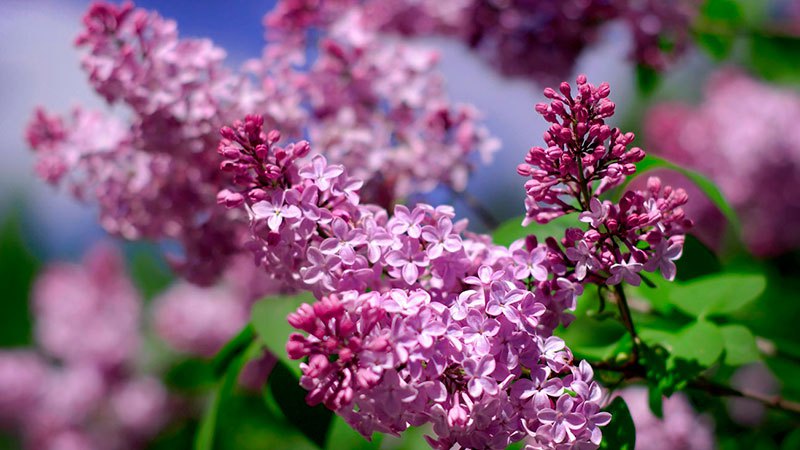
Spirea. This shrub changes during flowering. Its shape becomes cascading. This is due to the severity of the small white flowers. A variety of spirea can be divided into sub-varieties. In this quantity there are those trees that can bloom: in spring or summer.
Thanks to this factor, you can admire the flowering of Sperea from early spring to mid-autumn. In this case, it is recommended to plant a couple of bushes with different flowering periods. The height of such sub-cultivars can be 2.5 meters. But if you do not want to see an ogre shrub, you need to cut off its shoots after the flowering of the perennial.
Russian gardeners plant mainly Japanese varieties:
- "Golden Princess"
- "Shirobana".
The two varieties described above are distinguished by their diminutiveness. Their height can reach 70 cm. However, this will happen if the shrub is properly and competently cared for.
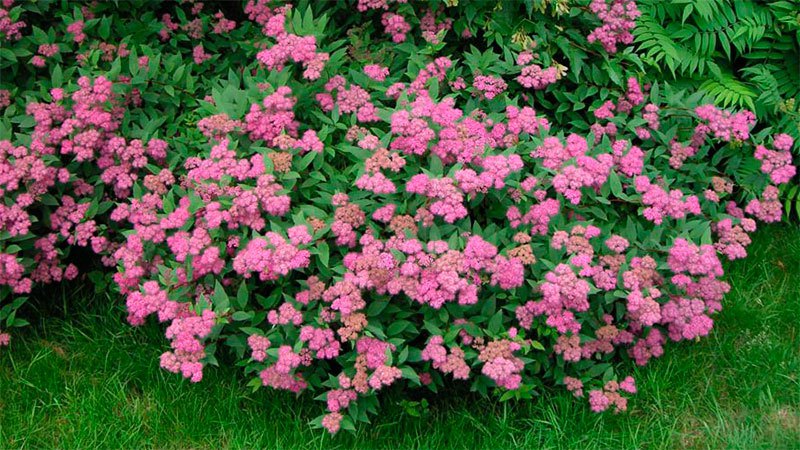
Buddley. This shrub thrives in temperate climates. The plant belongs to thermophilic. However, it can easily endure fairly low winter temperatures. However, before the onset of winter, it is necessary to cover the shrub with spruce branches and spud.
Buddleya is also a popular shrub. Color large lilac flowers from July to October. But if the autumn turned out to be warm, then the flowering time can be increased. A shrub can always be given an unusual and beautiful shape. One has only to prune immediately after flowering and the plant will delight you with its appearance.
But if you do not trim the shoots, then the height of the shrub can reach a height of 3 meters.
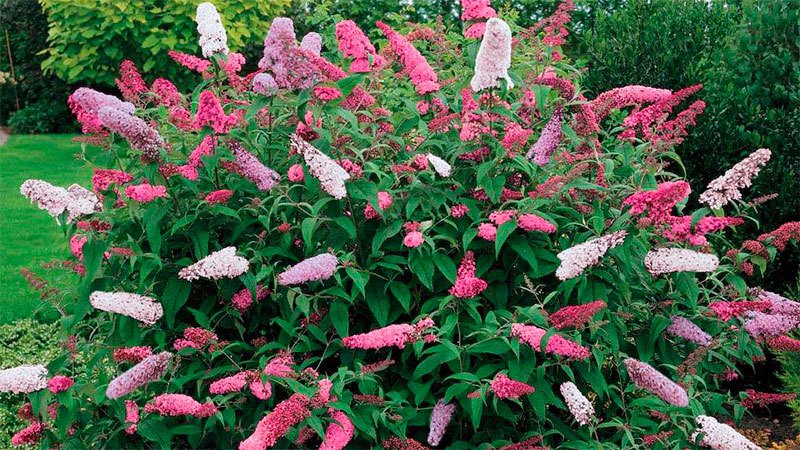
Hydrangea. In this article, we list for you unpretentious perennial shrubs that bloom all summer. Let's get acquainted with the next interesting shrub. A tree-like plant called hydrangea is able to please all gardeners with very large inflorescences. The shrub is distinguished by the fact that it can freely transfer even the most severe sub-zero temperatures.
The shrub needs mandatory pruning, which should be done a couple of times a year. The first pruning occurs after flowering. In this case, all young shoots that have not acquired a tree form are removed. The next pruning should be done in the spring. In this case, it is necessary to cut off the tops of the shrub, to the very top of the perennial bud that has not blossomed. The needs of the shrub include regular top dressing. In this case, those compositions are selected that have a high content of magnesium and iron.
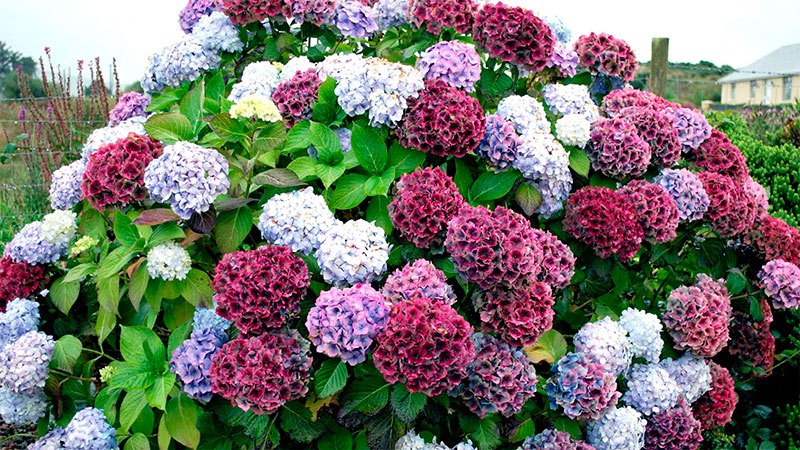
Above for you, we have listed beautiful perennial shrubs that bloom all summer. We managed to name only the most popular ones. These varieties will easily endure even the most difficult winter. But before landing any of them, it is still recommended to get acquainted with useful information.
Shade tolerant perennial shrubs
For growing in the garden, many summer residents choose shade-tolerant shrubs. These plants require minimal care, and their beauty can make absolutely any garden plot beautiful.
On a note! Shade-tolerant shrubs are recommended to be planted along country house or other commercial buildings.
Catalog of shade-tolerant perennials.
Wisteria. This shrub can have a height of 18 meters. This plant is used to decorate arches and few presentable buildings. To grow a plant, you need to stretch the threads that are pre-wrapped around a branch or bush. Wisteria flowers can bloom from late May to early September.
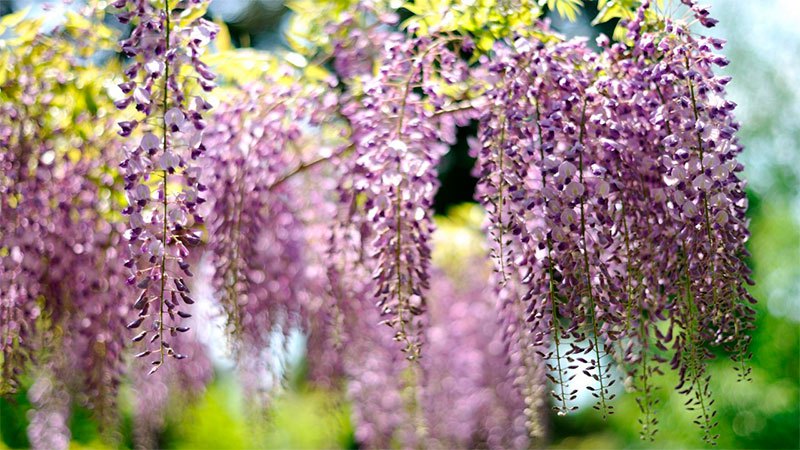
Weigela. This shrub reaches a height of 70-80 meters. Purple or pink flowers appear in late April. And if you take proper care of the shrub, then it will be able to bloom even until late autumn. The plant feels great in a dark place in warm weather. However, with the first frosts, the shrub throws off all its inflorescences.
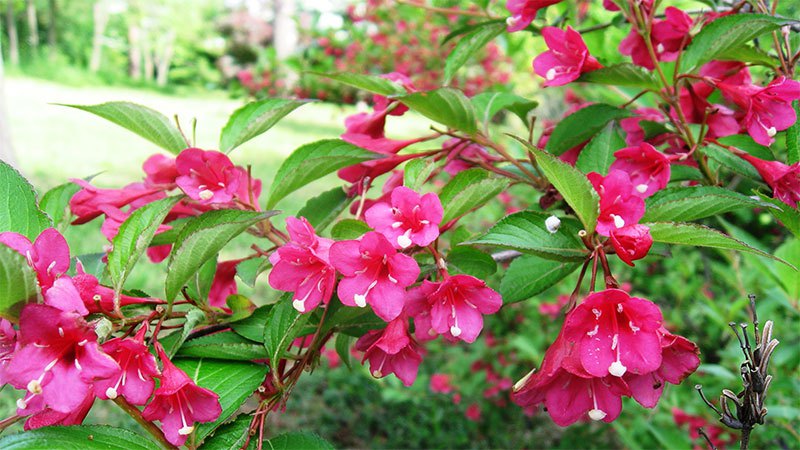
Action. This shrub has a small size and has a beautiful flowering. The plant begins to bloom in late spring. The flowers are small and have a pink or brown color. This shrub is involved in creating attractive compositions. You can plant several shrubs at once. So that the plant is always neat branches and shoots are constantly cut off.
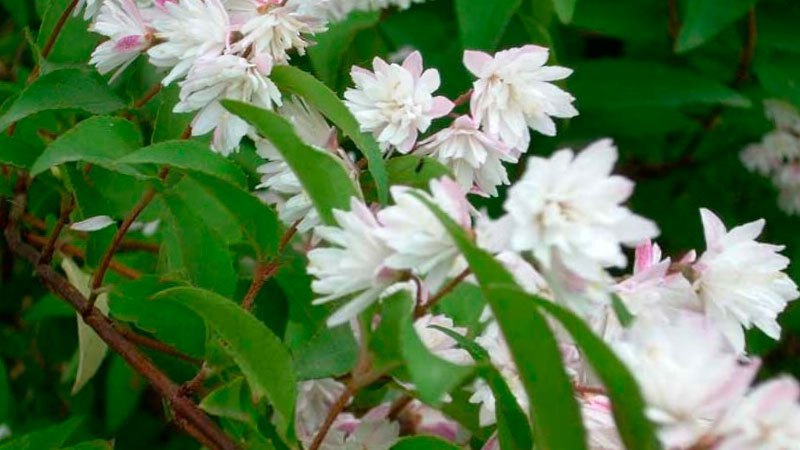
All perennial garden shrubs that like shade also tolerate winter well in Russia. But if the plant was planted in a region where a harsh climate prevails, then before the onset of winter, the shrub must be covered with special material.
Fast growing perennial shrubs
Shrubs that grow quickly are also popular among summer residents. With their help, you can quickly and easily create a hedge in the garden.
What shrubs are used to create hedges.
Dogwood. The berries of this shrub are widely used in folk medicine. The height of the shrub can be 5 meters. Thanks to this, this shrub is planted to create a hedge. The flowers of this shrub can be admired from March to May. And in the summer you can pick berries from the bush. This tree has a dense crown. Therefore, regular care is required here in the form of trimming the upper branches.
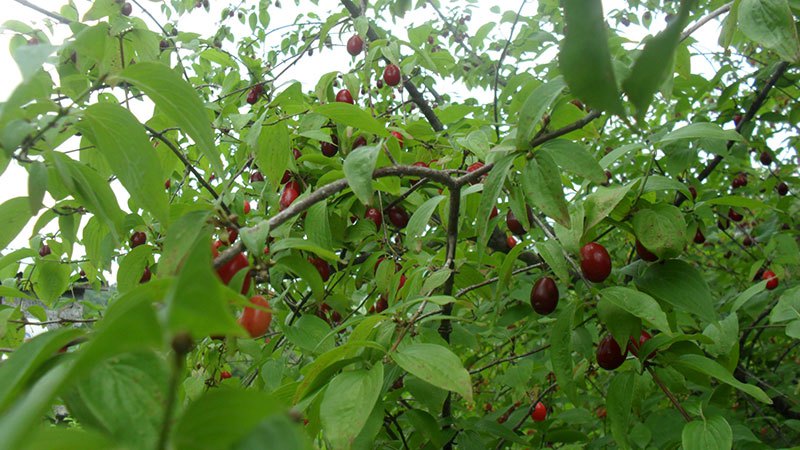
Barberry. To create a hedge, small varieties are mainly used. An unpretentious hedge will turn out due to the fact that the shrub has small thorns. Shrubs need to be looked after. Care consists of: feeding, watering and pruning.
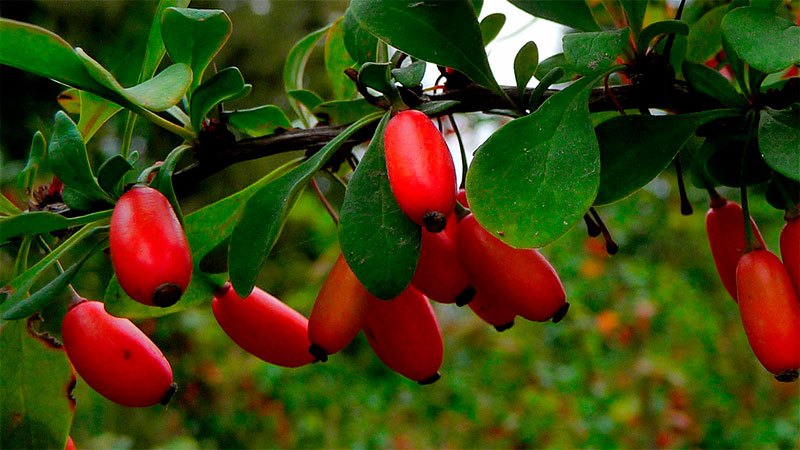
Turn. If this shrub grows freely, then its height can reach 3 meters. But to create a hedge, the shrub needs to have a more miniature look. Therefore, regular pruning will achieve this. It is worth noting that the blackthorn hedge is distinguished by the fact that during flowering a very pleasant aroma emanates from small flowers. And after the first frosts have passed, the fruits of this shrub can be eaten.
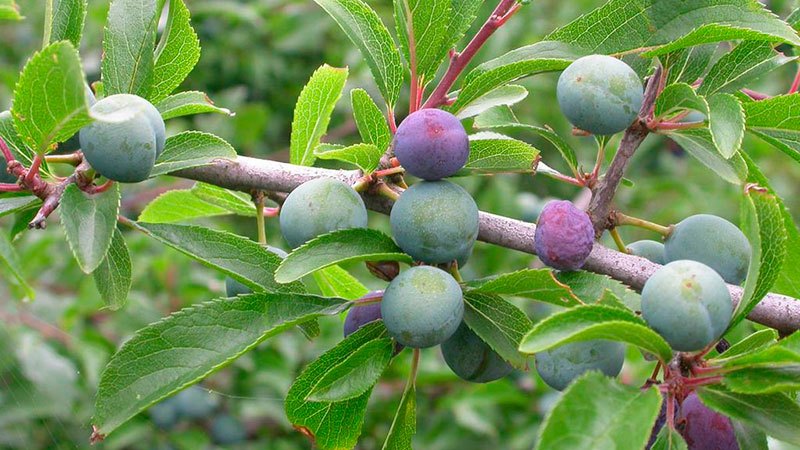
On a note! All types of shrubs that are listed above are fruit trees. Therefore, they carry two functions: fruits and beauty.
Finally
From this article, you could learn a lot for yourself interesting information. We hope you can choose for your garden exactly those shrubs that can decorate the summer cottage and make it attractive.
In conclusion, it is worth saying only that in the garden plots of many people, mainly fruit bushes are planted. These shrubs include: currants, raspberries, plums and cherries. To save space in the garden, it is recommended to plant several varieties of shrubs. In this case, you will be able to achieve the perfect effect.
Ornamental shrubs are an integral part of a beautiful garden. Of these, you can create a hedge, decorate the area in front of the house with them, zone the territory in the country. It is advisable to choose plants so that the flowering of one follows the flowering of the other, and flowering bushes coexisted with decorative leaves. At the same time, it is important to take into account the requirements of each shrub for the climatic conditions of Bashkiria and opt for zoned varieties and species. Caring for such plants will not require much effort, and they will decorate the garden all season long.
Criteria for the selection of shrubs for growing in the garden
Before planting perennial plants in the garden, you should familiarize yourself with which ones are suitable for growing in Bashkiria.
The main requirements that shrubs must meet:
- the ability to winter with minimal losses;
- drought resistance;
- wind resistance.
The climate of Bashkiria is distinguished by its stability. The main part of Bashkortostan is located in the southern part of the Urals, where the continental climate prevails. Winter is frosty, jumps and temperature fluctuations. In winter, the thermometer readings are rarely below minus 20-22°C. Snow cover is sufficient to prevent freezing of the roots of perennial frost-resistant plants.
The temperature below zero is set at the end of October, and its increase begins in the first ten days of April. Return frosts are possible until mid-May, in rare cases they occur until the end of the month. When choosing shrubs, it is better to plant late flowering varieties so that frost does not spoil the beauty of plants during flowering.
In summer, there is little precipitation, so it is preferable to opt for plants that are not demanding on the irrigation regime. There is almost no heat in summer. The average temperature is 20-23°C.
Due to the proximity to the steppes of Kazakhstan and the Orenburg region, there are strong winds in summer. Shrubs with brittle shoots should not be planted.
The main criterion in the selection of plants - it is important to be based not only on decorative qualities, but also on adaptability to the climatic conditions of the region. Frost resistance and drought resistance will allow shrubs to bloom beautifully and decorate the garden with minimal care for them. Other plants may need shelter for the winter and constant watering.
Beautiful flowering shrubs
Unpretentious flowering shrubs:
- spirea;
- lilac;
- mock orange (garden jasmine);
- viburnum buldenezh;
- hydrangea;
- bloodroot;
- honeysuckle honeysuckle (liana).
These shrubs are winter-hardy, easy to propagate and require watering only in hot weather.
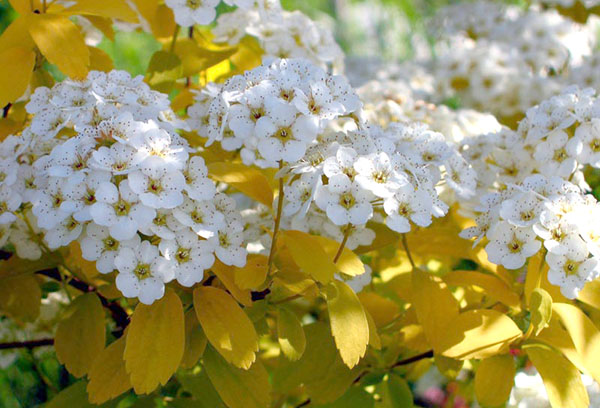
Spirea is unpretentious and hardy. It withstands frosts down to -30 °, tolerates drought easily. To prevent flowering from being short, it is advisable to water the bushes once every 10 days. If the site is fertile, you do not need to feed the plant. On poor soils, it is enough to fertilize every three years.
Spirea has many varieties. It can be short, about 60 cm, and tall, up to 2 meters. Branches can be upright and drooping. It blooms very profusely, the flowering period lasts up to three weeks. Flowers are collected in caps or panicles, the color is white, yellowish, pink or crimson.
Depending on the species, spirea blooms on the shoots of the current or last year. When cutting, this must be taken into account:
- bushes that bloom in spring on the shoots of last year are pruned immediately after flowering;
- if the spirea blooms in summer, then the shoots should be cut in early spring.
If you plant several varieties of spirea in the country, then flowering will come in a wave from May to July.
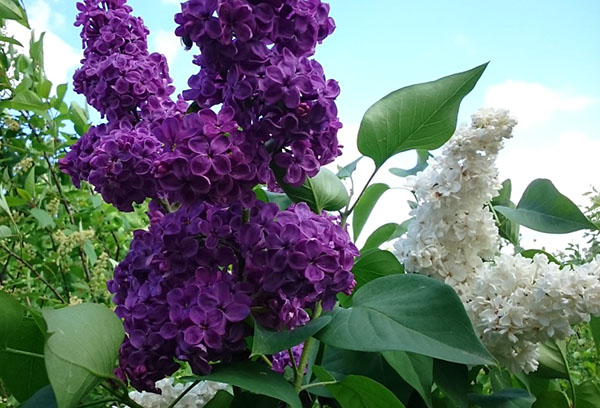
Lilac bloom begins at the end of May. The plant tolerates frosty winters, cold winds, in drought requires watering twice a month.
Lilac gives a lot of shoots, so it is suitable for growing as a hedge. A single plant is formed as a bush or tree:
- no more than 7 strong shoots are left for the bush, the rest of the shoots are cut out annually;
- 1-3 shoots are left for the tree. To form a stem, the lower branches are constantly cut at a height of up to 1 meter.
For annual abundant flowering, the faded tops of the shoots are cut out. This should be done immediately after flowering, until seeds have formed on the brushes. Late pruning will not bloom next year.
Common lilac is a success. Its flowers are simple and double, the color is white, lilac, lilac, the brushes are erect and drooping.
If space allows in the country, then in addition to this it is recommended to plant a Hungarian lilac. It blooms later, after the flowers on ordinary lilacs begin to dry out. The Hungarian lilac does not give growth, which makes it easier to care for it.
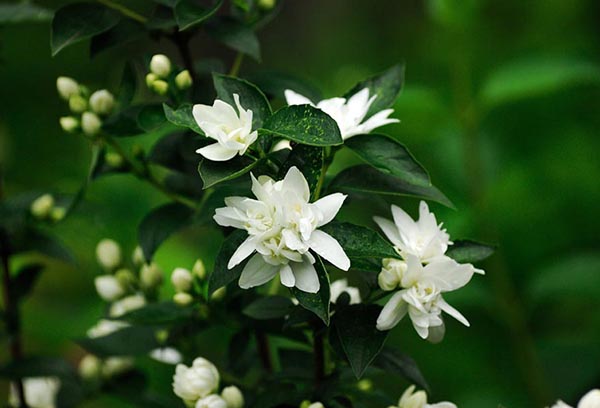
Jasmine garden is known to many under the name mock orange. The bushes are covered with snow-white flowers in early June. Having planted several different types, you can create a wave of flowering from June to August.
The first to bloom are varieties with simple flowers, which are distinguished by a delicious aroma.
Then terry types of mock orange blossom. Small flowers cover the entire plant, green foliage is not visible because of them. Terry species have almost no aroma.
For abundant flowering requires a sunny place, watering during a drought and pruning. Thickening, broken and old branches are pruned at the end of summer.
Fertilize the mock orange once every two years. The plant responds well to fertilizing with mullein infusion, wood ash and complex mineral fertilizer.
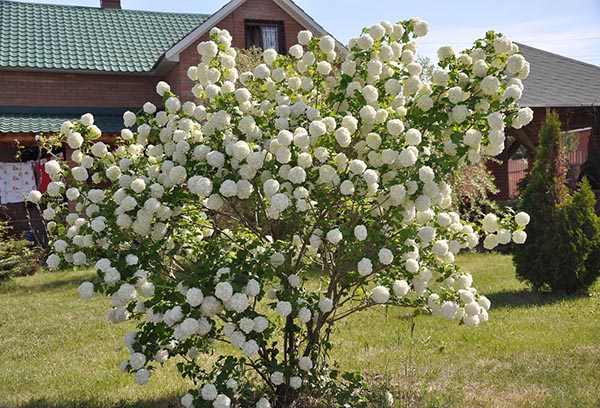
Kalina Buldenezh will not leave anyone indifferent. For a whole month it is covered with large white balls, each of which consists of many small flowers. Flowering is so abundant that under the weight of flowers the shoots bend to the ground.
Buldenezh grows in the form of a bush with several trunks. The maximum height can be up to 2.5 meters. To create a beautiful shape, pruning is carried out annually, immediately after the flowers crumble. Later pruning is unacceptable, because then shoots with flower buds will be removed and there will be no flowering next year.
For the stability of the plant, the trunks are tied together, sometimes support may be required. Kalina loves sunny places, partial shade is allowed for several hours. In drought it is necessary to water.
Winters well, but sometimes some of the shoots may freeze. They are cut out. This does not affect the decorativeness of the plant.
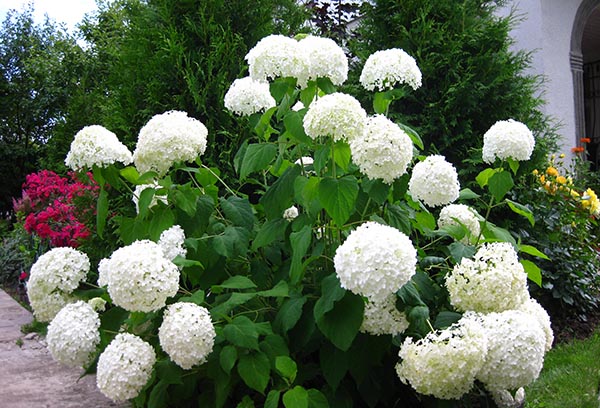
Hydrangea tree retains decorative properties until winter. The flowers are collected in hats, after light frosts the petals become translucent.
Grows best in partial shade. In the bright sun, the flowers become smaller and are not formed on every shoot.
Pruned in early spring, after the leaves begin to appear. At this time, it is noticeable whether there are frozen or dried branches.
In dry weather, regular watering is required.
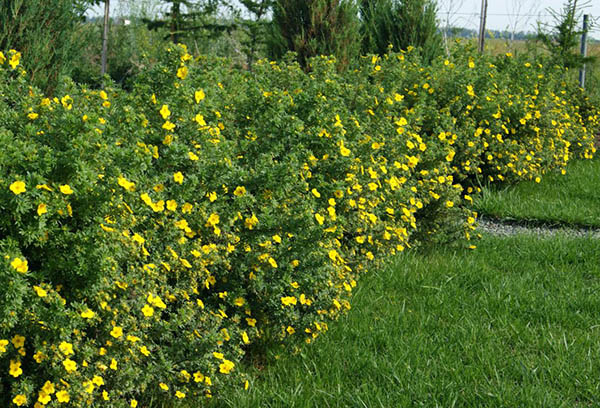
Potentilla shrub grows up to 1 meter, some specimens may be slightly higher. Its decorative properties are that the crown is dense, in the form of a ball, it forms itself without pruning. The entire bush is strewn with small flowers of yellow or pinkish-orange color.
In a sunny place it blooms from two months, starting from the end of June. It is desirable that in the midday heat a shadow from plants growing nearby falls on the cinquefoil.
In dry summers, abundant watering once a week is necessary. Pruning is necessary sanitary. It is carried out in the spring, cutting out broken and dried shoots.
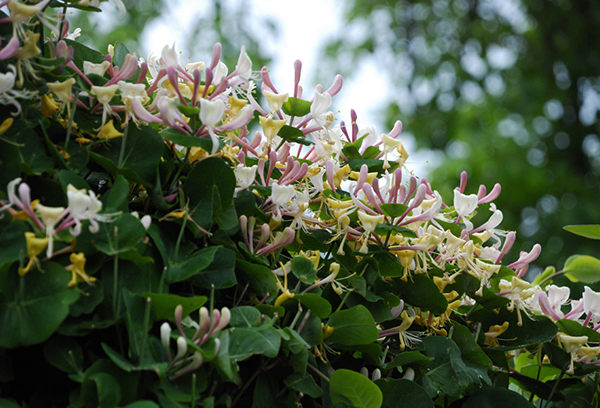
Honeysuckle honeysuckle is a perennial flowering vine. They are used for vertical gardening, a garter and direction of the lashes are required.
Blooms in late spring or early summer. Flowers of an unusual shape, white-pink or yellow. A pleasant aroma can be felt from a few meters away.
Abundant flowering is possible in bright sun, in the shade more leaves than flowers are formed. Tolerates drought for some time.
Winter-hardy, shoots rarely freeze slightly. If this happens, they should be cut off. For a year, the lashes grow by 1 meter.
Closer to autumn, orange round fruits are formed. They decorate the plant, unsuitable for food.
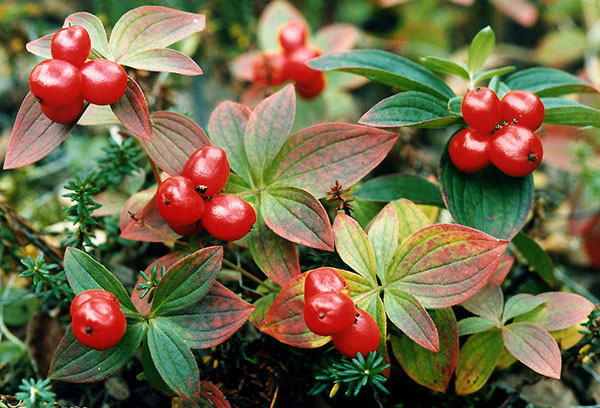
Next to the flowering plants in the country, decorative ones will look great, which are distinguished by an unusual shape or color of the foliage.
These shrubs include:
- sod;
- barberry;
- vesicle.
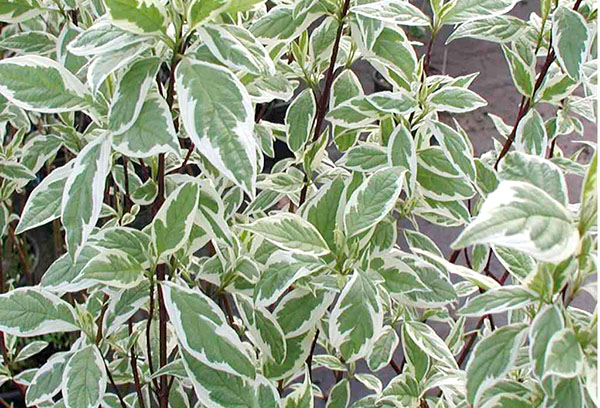
Derains - the variety of these shrubs never ceases to amaze. Their decorative properties are expressed not only in the foliage of unusual colors, which varies from light green to variegated. The shoots of some species in winter stand out against the background of white snow. They can be red, green, bright yellow or salmon.
Derain is frost-resistant, the shoots are flexible, do not break from strong winds and the severity of snow. Tolerates both drought and excessive soil moisture.
To maintain a compact shape, some branches are cut out every two years. Remove the oldest or weakest branches.
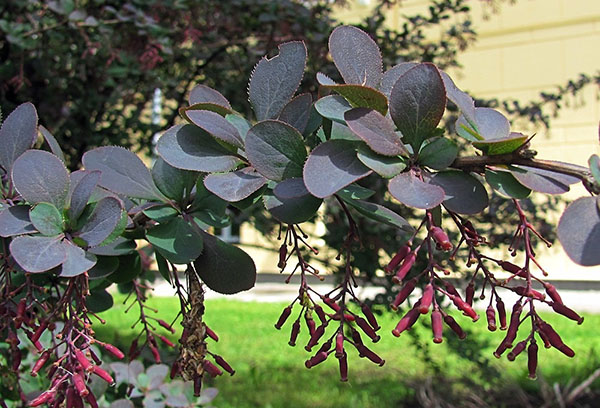
To create a hedge, an edible barberry is planted. The height of the bushes is up to 2.5 meters, and the prickly thorns make the thickets impenetrable. Its leaves are green in color. By autumn, they turn yellow and do not crumble for a long time. Long brushes with bright red berries adorn the plant all winter. Part of the fruit is eaten by birds in winter.
To decorate the site, decorative leaf species of barberry are planted. Their color can be yellowish, raspberry, brown. In many varieties, the leaves do not fall off in winter, or only some of them fall off. There are plants with erect shoots and arcuate ones that droop to the ground.
All types of barberry are winter-hardy and drought-resistant. Pruning is required sanitary - to remove dried branches.
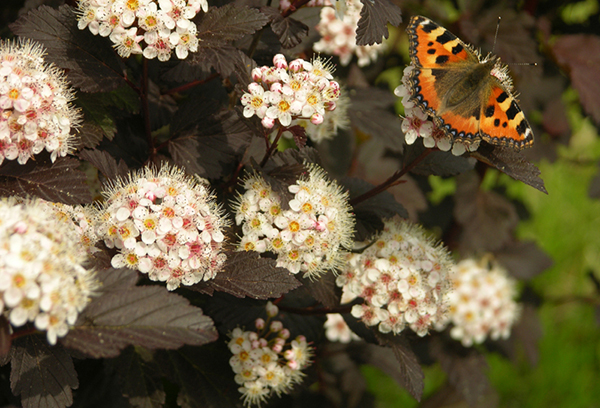
This plant has beautiful foliage color. Vesicles with light green and burgundy leaves are popular. It does not bloom for long, small flowers are collected in balls or hats. Due to the many stamens, the inflorescences seem fluffy.
Drought tolerant, needs occasional watering in dry weather. Winter-hardy. Only the tops of the shoots can freeze slightly, which are quickly restored after pruning.
The bush is grown compact or in the form of a fountain. A compact form is given by pruning all shoots at a height of 40-50 cm. The upper buds quickly start growing.
If you cut out some of the weak shoots at the base, the remaining branches will stretch upwards, and their upper part will bend in different directions, which will give the bush a beautiful fountain shape.
Conclusion
A variety of species and varieties of unpretentious shrubs allows you to design a garden plot so that it is beautiful throughout the season. Properly selected plants make the garden bloom from May to September, and decorative leaves of shrubs add brightness and contrast.
- decrease in the body's immune defenses
- drowsiness
- frequent fatigue
- depression
- headaches, as well as various pains and spasms in the internal organs
If you feel frequent ailments, you just need to cleanse the body. How to do it
You need to decorate the garden wisely, so to speak, with feeling, really, with arrangement. Perennial ornamental shrubs are certainly an important element in any garden. Properly planted, they give a noble look to any space. In summer, flowering bushes will green up and fill any corner of the garden with a wonderful aroma. Let's look at some perennial shrubs and flowers that will turn your garden dreams into a beautiful reality.
Probably, in every garden there is viburnum, lilac, jasmine - in hot weather they create a blissful shadow, during flowering they fill all corners of the garden with a rich aroma. But besides these regulars of any site, there are many other ornamental perennial shrubs. And that's who you can "invite" to live in the garden.
Decorative bush asters are perhaps the brightest of the possible options. The variety of varieties allows you to create the effect of continuous flowering, using only asters. Straight stems, depending on the variety, grow up to 50 cm. Flowers resemble baskets, each of which is up to 3 cm in diameter.
Early varieties include alpine asters growing up to 30 cm. They bloom from the beginning of June, with single buds up to 6 cm in diameter. The colors are very diverse - all shades of purple, pale lilac, blue and deep blue, creamy white.
If you prefer tall plants, then the Bessarabian aster variety will satisfy your request - they grow up to 75 cm in height. The flowers of this subspecies are numerous, purple in color with a dark core. Another height champion is the New England variety, which grows up to 2 m. Its inflorescences are collected in brushes of 25-30 pieces, bloom in September.
By color, decorative and border asters are divided into many types:
- Alba - snow-white;
- Superbus and Troyes - blue;
- Rum, Guthe, Heinrich Seibert - all shades of pink;
- Dwarf, Herman Lehne, Dunkle Schone - from pale lilac to dark purple, almost black;
- Ruber, Bars Pink, Rubishatz, Beechwood Ravel - from light red to deep burgundy.
Asters, of course, are not the only perennial shrubs that bloom in summer and autumn. Buddley - tall plant very similar to lilac. It blooms in early summer and keeps flowers until autumn frosts. Distinctive feature buddley is that it attracts butterflies.
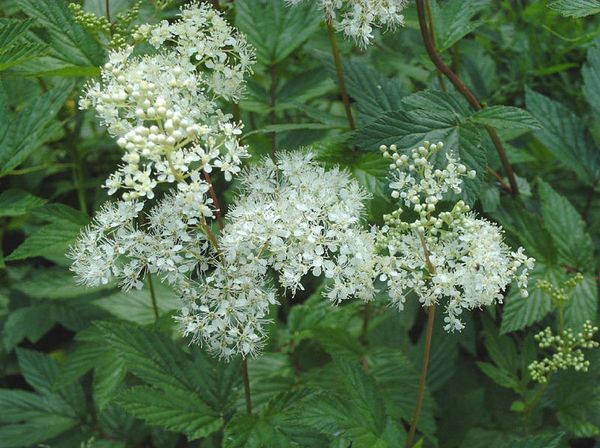
Spirea, or Meadowsweet, is an unpretentious tall shrub that will surprise you with the variety of forms that its crown can take: spherical, pyramidal, cascade-like. It blooms all summer, and you can plant it anywhere in the garden. Hydrangea paniculata, whose bushes bloom with many white inflorescences, will also surprise you with its growth - up to 3 m. blooming summer, while as it fades, its flowers change color from white to pale pink.
Weigela is a tall plant that represents curb shrubs reaching a mark of 2.5-3 m. Calicant - flowering shrubs with delicate buds resembling water lilies in shape. A medium-sized plant that blooms in June will easily settle in any garden plot.
Fill your garden with bright yellow flowers in spring - forsythia. Curious is the fact that forsythia blooms first, and then releases green leaves. Blooming at the very beginning of spring, it looks good both separately from other plants and in group plantings.
Rhododendron is an incredibly beautiful and incredibly whimsical plant. Divide rhododendrons into three large groups: evergreen, wintering, deciduous. We advise you to pay attention to the Japanese Rhododendron, which will bring a touch of originality to the garden labyrinths. It blooms from June to July.
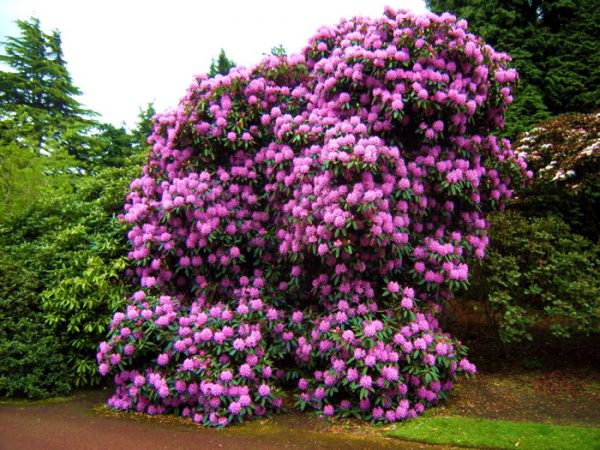
Kolkvitsia is a close relative of Weigela and Honeysuckle. Kolquitsia bushes grow up to 2 m, pleasing the eye with straight, densely pubescent branches. The flowers look like deep pink bells, collected in inflorescences up to 7 cm in diameter.
The hibiscus is not to be missed. Varieties Syrian, Diana, Vayelit Ilar Double, Pink Giant will delight you with abundant flowering and large buds. Also belongs to the group of curb shrubs.
Video "Perennial ornamental shrubs for the garden"
Video review of perennial shrubs that bloom throughout the summer. Planting, care and cultivation of plants in the garden.
Pay attention to dwarf spruces, which do not exceed 2-2.5 m in height. For example, the Nidiformis variety, about 1 m high, has a crown 2 m in diameter, while being frost-resistant. The Tompa variety has a wide conical shape, grows up to 1.5 m, a big plus of this spruce is that the crown does not need to be cut or somehow looked after. Will's Zwerg has a narrow conical crown with light green needles. The Karel variety looks like a prickly dark green pouf, grows up to only 1.5 m.
Japanese quince is a frost-resistant plant. If desired, you can easily give any shape to the quince crown when it has already faded, that is, starting in July. Jasmine, or Chubushnik, will delight you with its lush flowering, the dense aroma of flowers, and rich greenery throughout the warm season. Blooms in June-July.
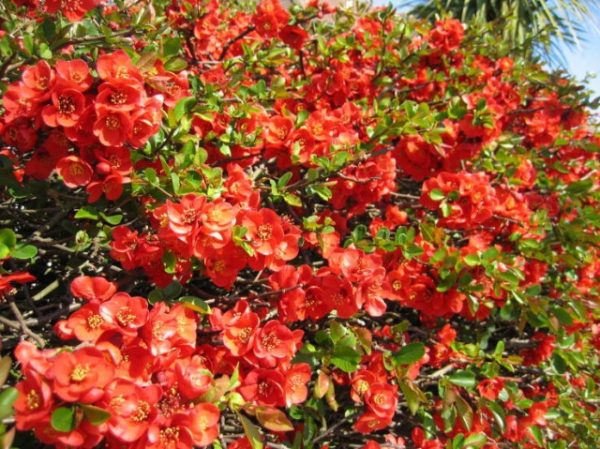
Weaving roses create the effect of a floral cloud with an incredible, dense aroma. It is convenient not only because it curls on any more or less suitable surface, but also in its easy proximity to any colors. For example, asters - perfectly set off and complement the flowering of a weaving rose.
Heather - grows in low bushes up to 80 cm tall. It blooms all summer, very abundantly with beautiful white, pink or red buds. Irga canadensis is a lush green plant with sweet berries. Irgi has interesting oval, slightly pointed, leaves covered with fluff on the underside. The buds are erect, collected in a brush. After a long flowering, the irga acquires bright red fruits, which darken over time, acquiring a bluish bloom.
Potentilla - blooms with the arrival of the May heat with many small flowers of white or bright yellow. If your garden lacks rich yellow colors, then pay attention to the varieties Dakota sunrise and Goldfinger; among the white flowers, the best are Beani and Abbotswood. The height of the cinquefoil rarely exceeds 1.5 m.
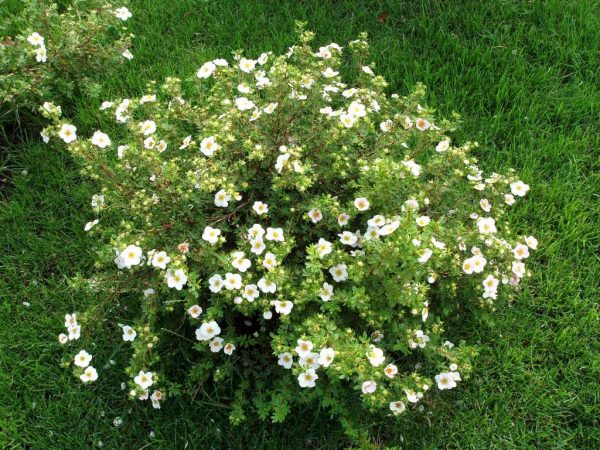
How to create continuous bloom
Plants that bloom all year round are the cherished dream of any gardener. And to achieve this is not so difficult. The set of plants for planting depends on just a few factors:
- landing site;
- the flowering time of each plant - it is worth planting together those plants that bloom one after another;
- landing composition.
Border asters with their flowering cover the entire warm season, starting to bloom from late April until November. In spring bloom: forsythia, quince, spirea, almonds. In the summer they continue the flower business: barberry, hydrangea, jasmine, weigela, rhododendron, asters.
Bloom in autumn: hydrangea, heather, mountain ash, the same asters. Creating a continuous bloom is really easy. First, think over the planting plan, where you would like to add this or that plant, sketch it so as not to forget, make clear notes / notes. Decide on the style in which you want to see the bushes. For European compositions, mock orange, barberry, hydrangea, asters are suitable; for oriental style - rhododendron, quince, forsythia, almonds.
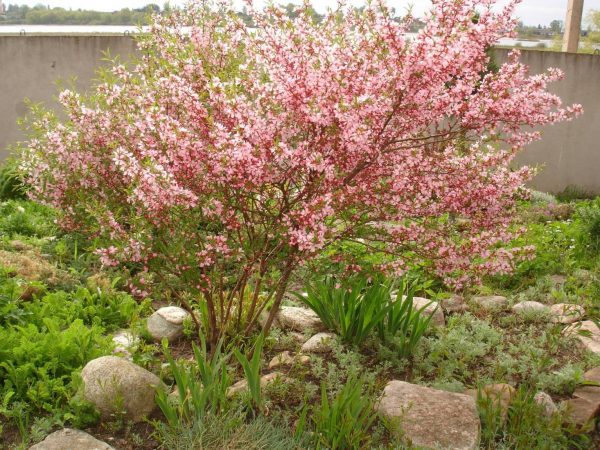
The point of view is also important - arrange all types of plants so that when people enter the garden they see the best sides of your plantings. And since we are talking about the landing site, then pick up low-growing and medium-sized plants (for example, asters, marigolds) for garden paths, leaving tall ones for the central sections of the flower beds. Don't be afraid to be creative when composing your ever-blooming paradise and then you will get an amazingly beautiful result.
Every gardener dreams of shrubs blooming all summer long on his plot. It is possible to fulfill such a desire, it is enough to collect as much information as possible about suitable species and varieties. The list of flowering plants is large, you just have to choose the most suitable options for yourself.
Flowering shrubs to give: description
- Budleya is a beautiful plant that looks like a lilac. It can grow up to 3 m. During flowering, a delicate and pleasant aroma emanates from the bush. It lasts from the very beginning of summer until the first frost. The plant has different colors: purple, blue, white, pink, lavender, etc. If you remove fading brushes and leaves in time, you can extend the flowering time of the budley. This shrub is ideal for decorating flowerbeds, slopes, borders, etc.
- Kariopteris is a shrub on which brushes bloom blue flowers. He is not picky about care, he is not afraid of either drought or heat. In height, the shrub can reach up to 1.5 m. It is often used to decorate borders, flower beds and containers.
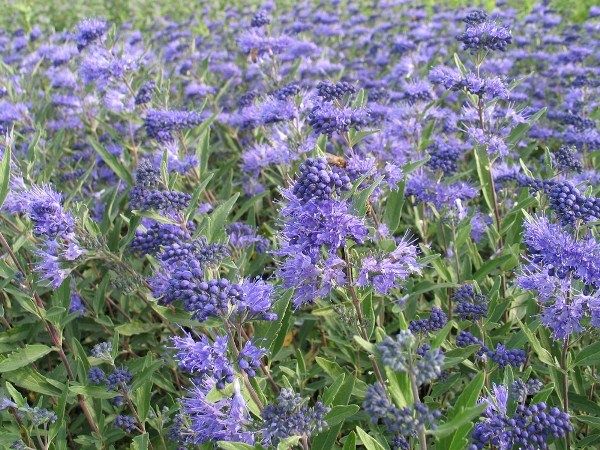
- Calicant. Amazing graceful flowers resembling water lilies and beautiful glossy foliage turn calicant into one of the most original shrubs that bloom all summer. He is able to fill your garden with a pleasant aroma. Calicant does not require special care. The plant is quite hardy and unpretentious.
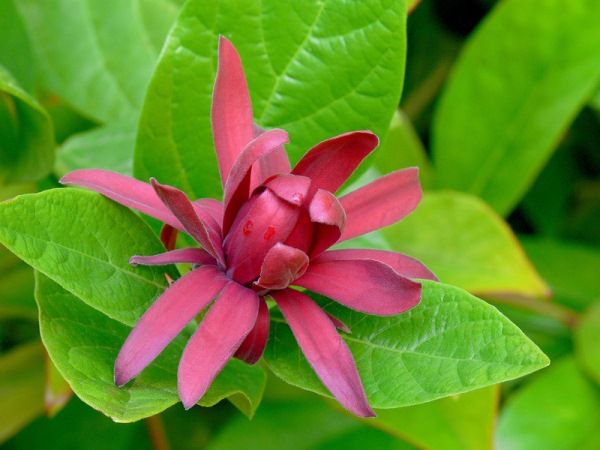
- Small hydrangea is the easiest of all types of hydrangea to care for. It is showered with fluffy tassels of white flowers. As they fade, the brushes take on pink and green hues. Dried inflorescences are creamy-beige. Some hydrangea varieties can be grown in the form of a tree, which is ideal for a large tub.
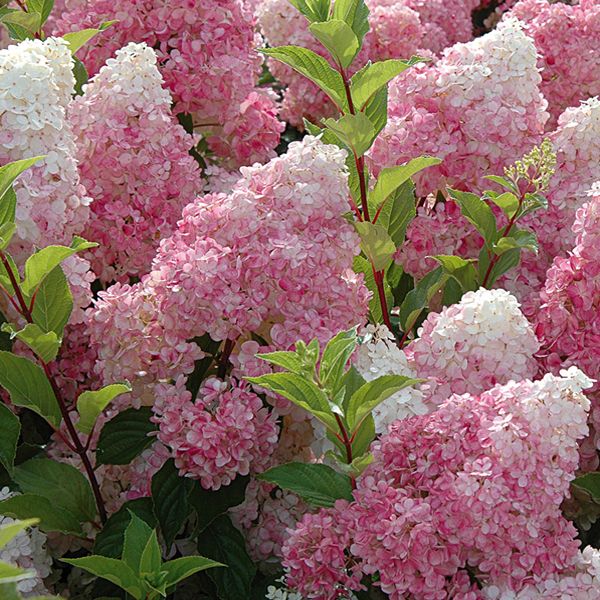
- Oleander will please flower growers with its shades of pink, purple, yellow, red, lilac and white flowers. This shrub is quite thermophilic, and also poisonous. Having planted it in your garden plot, make sure that the children do not touch its foliage and branches! Oleander grows in a large bush that forms a beautiful wall. In cold regions, this shrub is grown in containers and brought indoors in winter. Oleander prefers moist, well-drained soil and full sun.
- Potentilla is one of the most common and easy-to-care shrubs that blooms all summer. It begins to bloom in late spring and continues to do so until the first frost. Potentilla colors can be very diverse: white, orange, red and yellow. Potentilla needs good drainage, it loves the open sun. The shrub has proven itself in folk medicine.
Flowering shrubs: list with names
- Cistus is a very beautiful plant whose flowers look like poppies or non-double roses. It blooms throughout the summer. Cistus shades can be very diverse - from pale pink to purple. Some species secrete gum, which the ancient Greeks used to make perfume and in medicine.
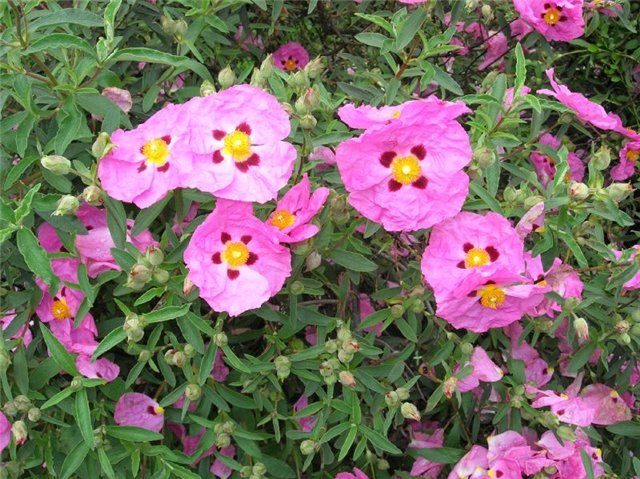
- spray rose- resistant to frost and various diseases. These are the hardiest of roses, they bloom throughout the season, or bloom again after a certain period of time. Plants have whole line flowers of various shapes, vary in color and aroma. Some bushes are very tall, others are small and compact. The flower can be both monophonic and two-colored. The spray rose comes in almost all colors except blue. The plant has thorns, so do not plant it near paths.
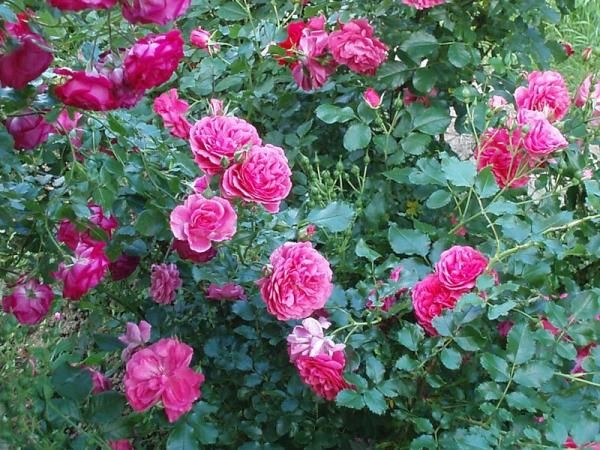
- The tannery skumpia is a very spectacular shrub. Most common cultivars of skumpia have deep purple foliage that turns to striking yellow, orange and red leaves in autumn. Skumpia has the form of a large shrub or graceful tree with a branchy crown resembling an umbrella or a ball. The plant reaches 4 - 5 m in height, and in a subtropical climate it grows up to 12 m. The life expectancy of skumpii is up to 100 years.
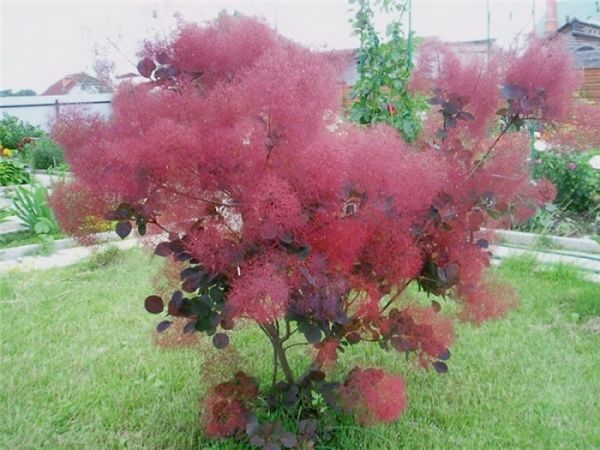
- Alder leaf cletra is almost indispensable in ornamental horticulture for planting in wetlands. Most often used in mixed plantings with rhododendrons and other plants, because calcium or. The flowers are pink and golden color with a wonderful aroma. It blooms on the shoots of the current year, so sanitary pruning is best done in the spring. The soil prefers acidic, fertile and drained.
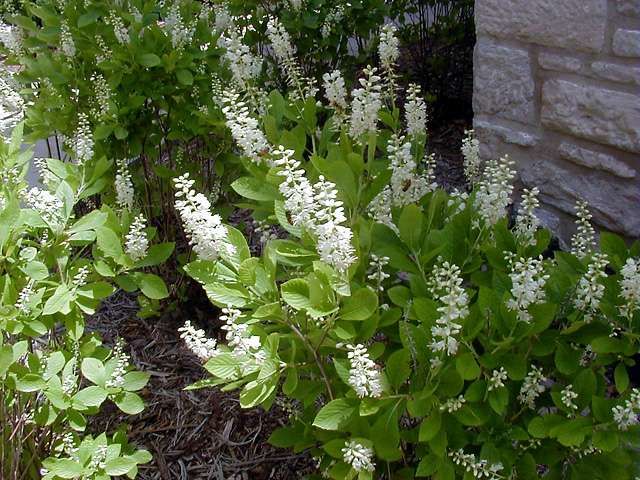
- Meadowsweet, or as it is also called, spirea. The shrub has an intoxicating aroma, it is often used in folk medicine and for cooking some dishes. The bush is incredibly tenacious, you can practically not care for it. They can decorate any place on the site, spirea is especially suitable for creating a cozy corner. Meadowsweet flowers are numerous, pink or white, small, collected in terminal brush-like paniculate inflorescences at the ends of the shoots. Meadowsweet prefers wet places - this plant can be found in swampy areas, in damp meadows, along river banks, on the slopes of ravines soaked with moisture.
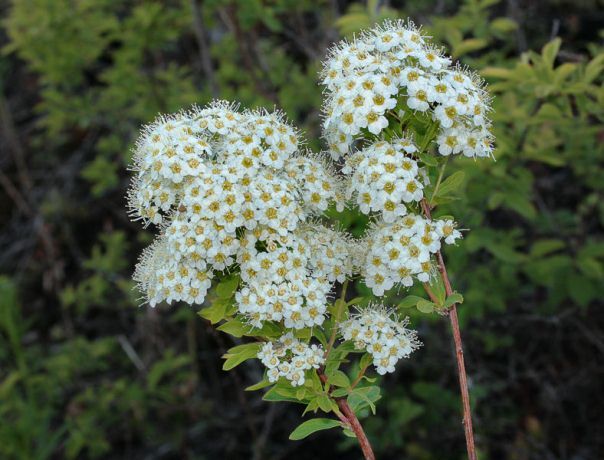
Flowering shrubs: photo
